Attached files
| file | filename |
|---|---|
| 8-K - 8-K - MidWestOne Financial Group, Inc. | mofg-20201109.htm |

Investor Presentation September 30, 2020
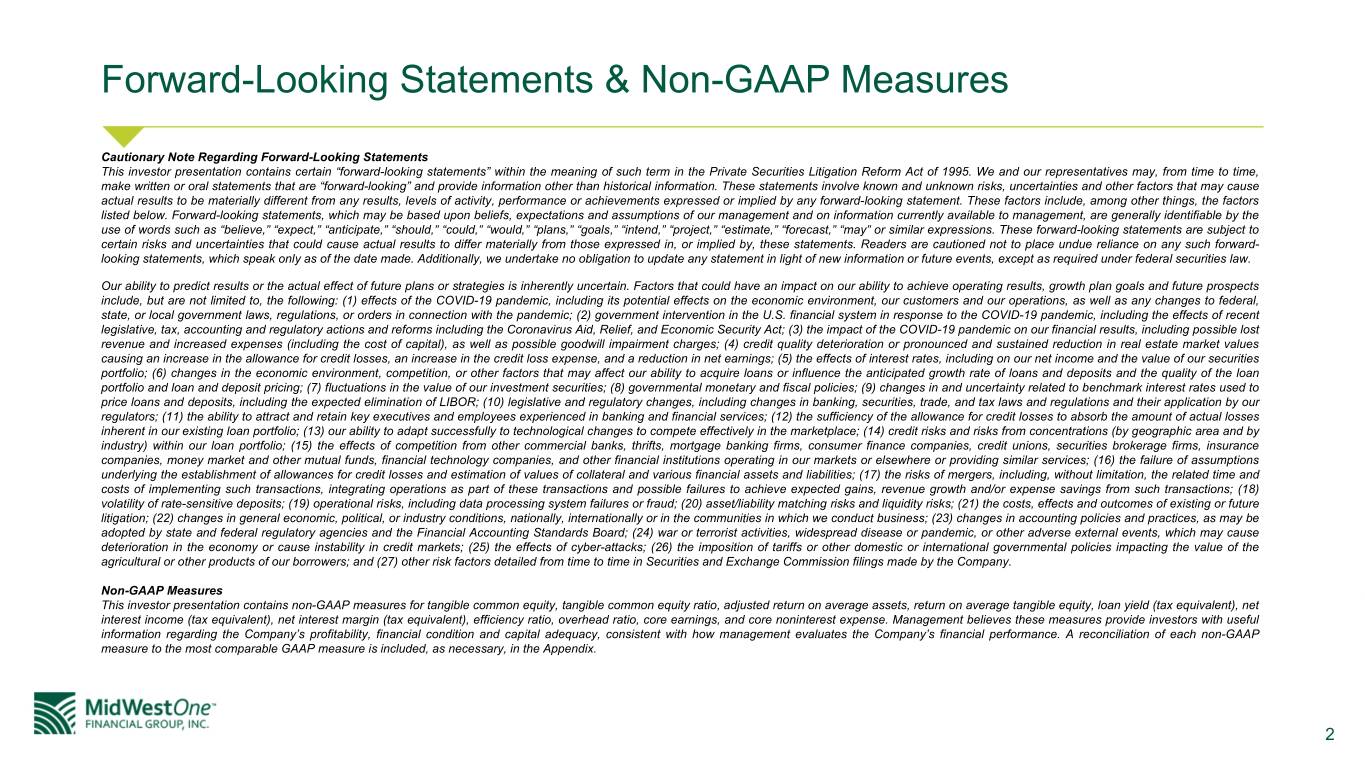
Forward-Looking Statements & Non-GAAP Measures Cautionary Note Regarding Forward-Looking Statements This investor presentation contains certain “forward-looking statements” within the meaning of such term in the Private Securities Litigation Reform Act of 1995. We and our representatives may, from time to time, make written or oral statements that are “forward-looking” and provide information other than historical information. These statements involve known and unknown risks, uncertainties and other factors that may cause actual results to be materially different from any results, levels of activity, performance or achievements expressed or implied by any forward-looking statement. These factors include, among other things, the factors listed below. Forward-looking statements, which may be based upon beliefs, expectations and assumptions of our management and on information currently available to management, are generally identifiable by the use of words such as “believe,” “expect,” “anticipate,” “should,” “could,” “would,” “plans,” “goals,” “intend,” “project,” “estimate,” “forecast,” “may” or similar expressions. These forward-looking statements are subject to certain risks and uncertainties that could cause actual results to differ materially from those expressed in, or implied by, these statements. Readers are cautioned not to place undue reliance on any such forward- looking statements, which speak only as of the date made. Additionally, we undertake no obligation to update any statement in light of new information or future events, except as required under federal securities law. Our ability to predict results or the actual effect of future plans or strategies is inherently uncertain. Factors that could have an impact on our ability to achieve operating results, growth plan goals and future prospects include, but are not limited to, the following: (1) effects of the COVID-19 pandemic, including its potential effects on the economic environment, our customers and our operations, as well as any changes to federal, state, or local government laws, regulations, or orders in connection with the pandemic; (2) government intervention in the U.S. financial system in response to the COVID-19 pandemic, including the effects of recent legislative, tax, accounting and regulatory actions and reforms including the Coronavirus Aid, Relief, and Economic Security Act; (3) the impact of the COVID-19 pandemic on our financial results, including possible lost revenue and increased expenses (including the cost of capital), as well as possible goodwill impairment charges; (4) credit quality deterioration or pronounced and sustained reduction in real estate market values causing an increase in the allowance for credit losses, an increase in the credit loss expense, and a reduction in net earnings; (5) the effects of interest rates, including on our net income and the value of our securities portfolio; (6) changes in the economic environment, competition, or other factors that may affect our ability to acquire loans or influence the anticipated growth rate of loans and deposits and the quality of the loan portfolio and loan and deposit pricing; (7) fluctuations in the value of our investment securities; (8) governmental monetary and fiscal policies; (9) changes in and uncertainty related to benchmark interest rates used to price loans and deposits, including the expected elimination of LIBOR; (10) legislative and regulatory changes, including changes in banking, securities, trade, and tax laws and regulations and their application by our regulators; (11) the ability to attract and retain key executives and employees experienced in banking and financial services; (12) the sufficiency of the allowance for credit losses to absorb the amount of actual losses inherent in our existing loan portfolio; (13) our ability to adapt successfully to technological changes to compete effectively in the marketplace; (14) credit risks and risks from concentrations (by geographic area and by industry) within our loan portfolio; (15) the effects of competition from other commercial banks, thrifts, mortgage banking firms, consumer finance companies, credit unions, securities brokerage firms, insurance companies, money market and other mutual funds, financial technology companies, and other financial institutions operating in our markets or elsewhere or providing similar services; (16) the failure of assumptions underlying the establishment of allowances for credit losses and estimation of values of collateral and various financial assets and liabilities; (17) the risks of mergers, including, without limitation, the related time and costs of implementing such transactions, integrating operations as part of these transactions and possible failures to achieve expected gains, revenue growth and/or expense savings from such transactions; (18) volatility of rate-sensitive deposits; (19) operational risks, including data processing system failures or fraud; (20) asset/liability matching risks and liquidity risks; (21) the costs, effects and outcomes of existing or future litigation; (22) changes in general economic, political, or industry conditions, nationally, internationally or in the communities in which we conduct business; (23) changes in accounting policies and practices, as may be adopted by state and federal regulatory agencies and the Financial Accounting Standards Board; (24) war or terrorist activities, widespread disease or pandemic, or other adverse external events, which may cause deterioration in the economy or cause instability in credit markets; (25) the effects of cyber-attacks; (26) the imposition of tariffs or other domestic or international governmental policies impacting the value of the agricultural or other products of our borrowers; and (27) other risk factors detailed from time to time in Securities and Exchange Commission filings made by the Company. Non-GAAP Measures This investor presentation contains non-GAAP measures for tangible common equity, tangible common equity ratio, adjusted return on average assets, return on average tangible equity, loan yield (tax equivalent), net interest income (tax equivalent), net interest margin (tax equivalent), efficiency ratio, overhead ratio, core earnings, and core noninterest expense. Management believes these measures provide investors with useful information regarding the Company’s profitability, financial condition and capital adequacy, consistent with how management evaluates the Company’s financial performance. A reconciliation of each non-GAAP measure to the most comparable GAAP measure is included, as necessary, in the Appendix. 2
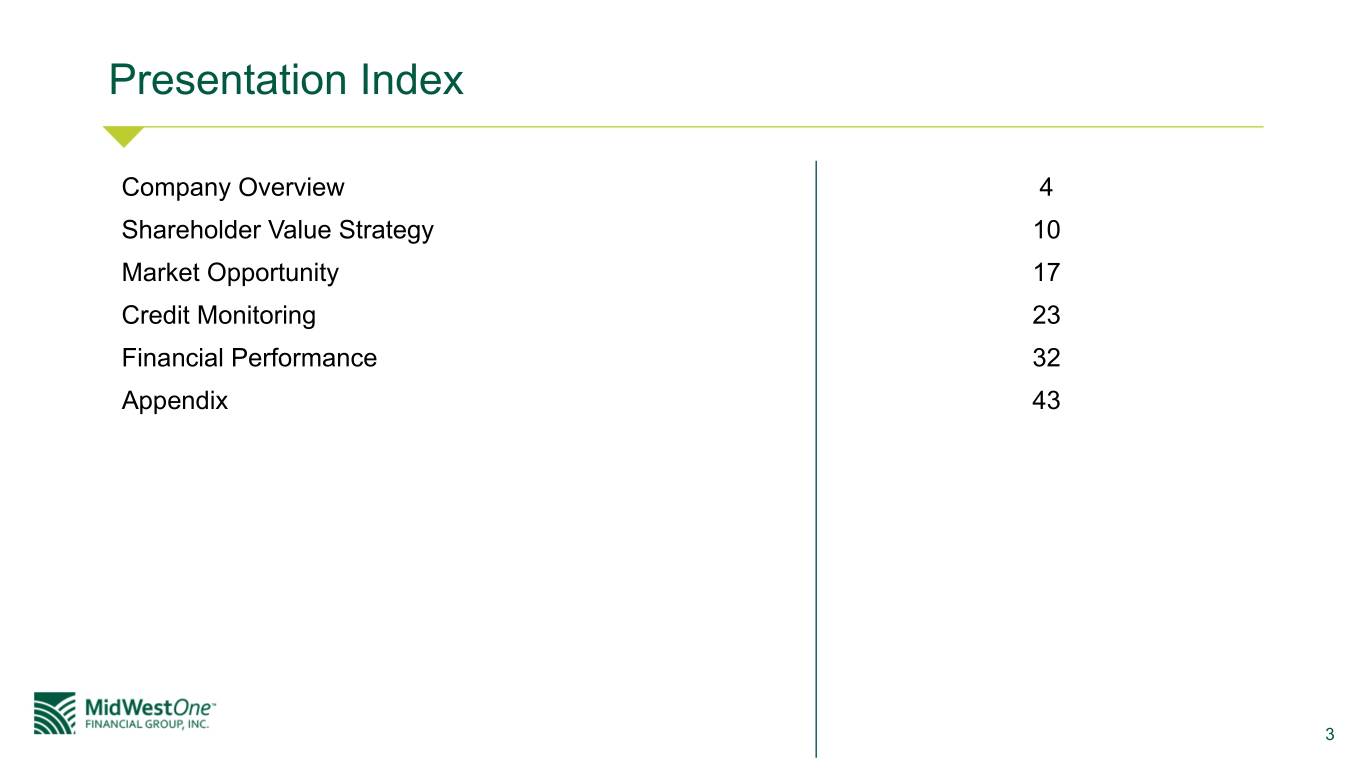
Presentation Index Company Overview 4 Shareholder Value Strategy 10 Market Opportunity 17 Credit Monitoring 23 Financial Performance 32 Appendix 43 3
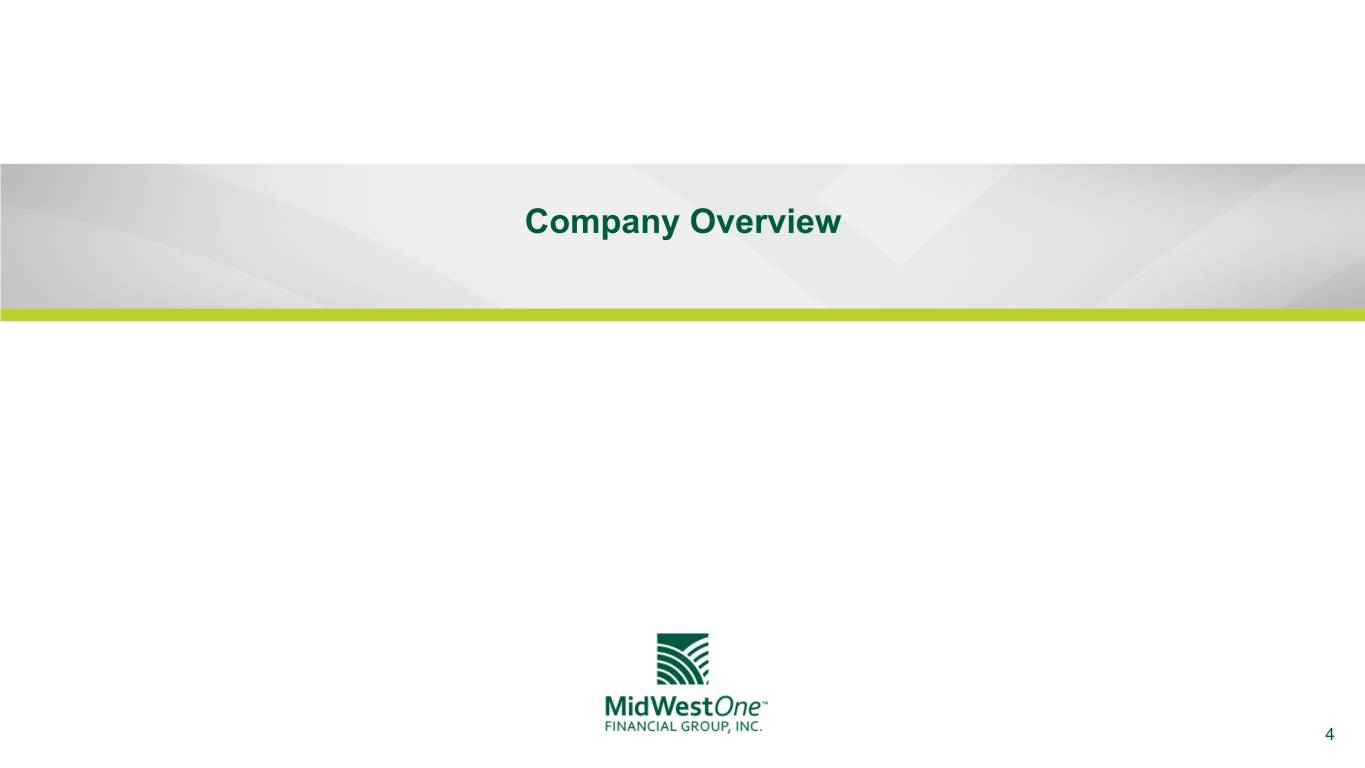
Company Overview 4
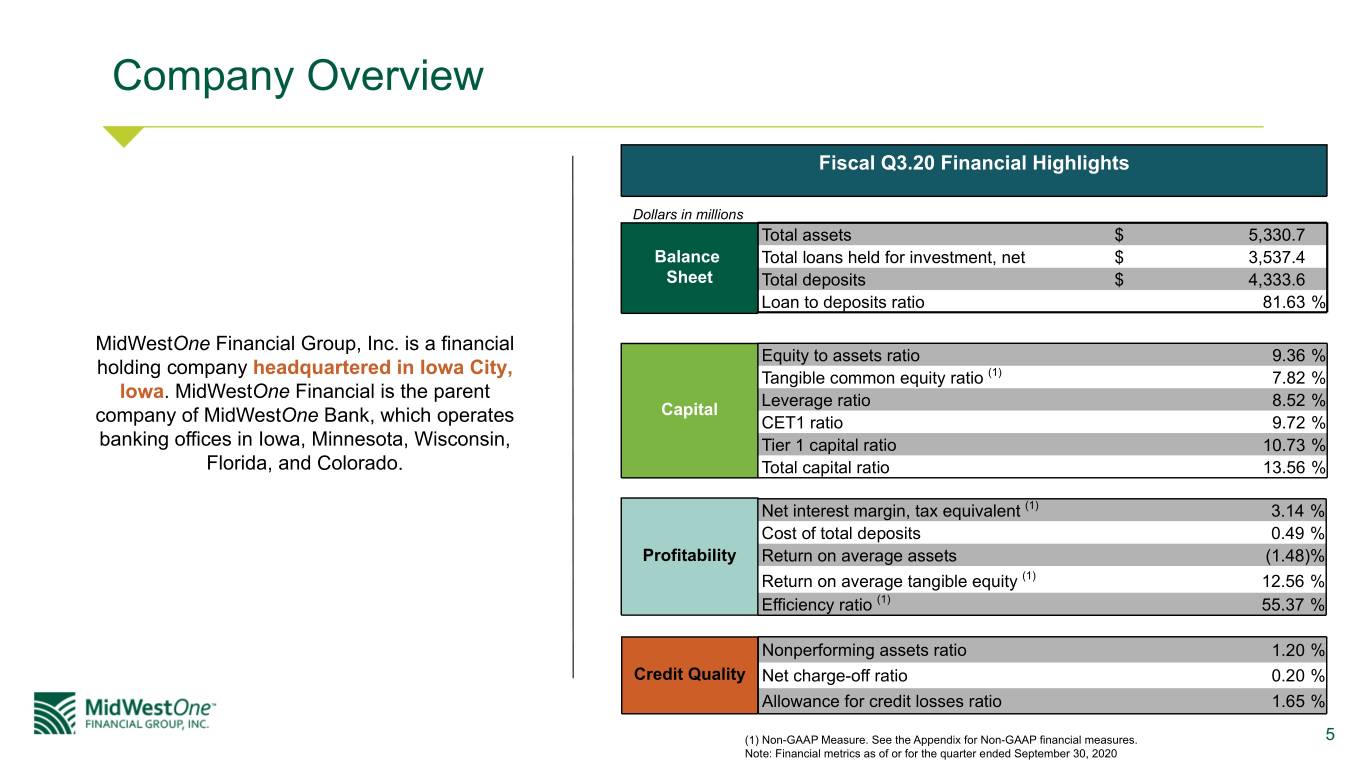
Company Overview Fiscal Q3.20 Financial Highlights Dollars in millions Total assets $ 5,330.7 Balance Total loans held for investment, net $ 3,537.4 Sheet Total deposits $ 4,333.6 Loan to deposits ratio 81.63 % MidWestOne Financial Group, Inc. is a financial Equity to assets ratio 9.36 % holding company headquartered in Iowa City, Tangible common equity ratio (1) 7.82 % Iowa. MidWestOne Financial is the parent Leverage ratio 8.52 % Capital company of MidWestOne Bank, which operates CET1 ratio 9.72 % banking offices in Iowa, Minnesota, Wisconsin, Tier 1 capital ratio 10.73 % Florida, and Colorado. Total capital ratio 13.56 % Net interest margin, tax equivalent (1) 3.14 % Cost of total deposits 0.49 % Profitability Return on average assets (1.48) % Return on average tangible equity (1) 12.56 % Efficiency ratio (1) 55.37 % Nonperforming assets ratio 1.20 % Credit Quality Net charge-off ratio 0.20 % Allowance for credit losses ratio 1.65 % (1) Non-GAAP Measure. See the Appendix for Non-GAAP financial measures. 5 Note: Financial metrics as of or for the quarter ended September 30, 2020
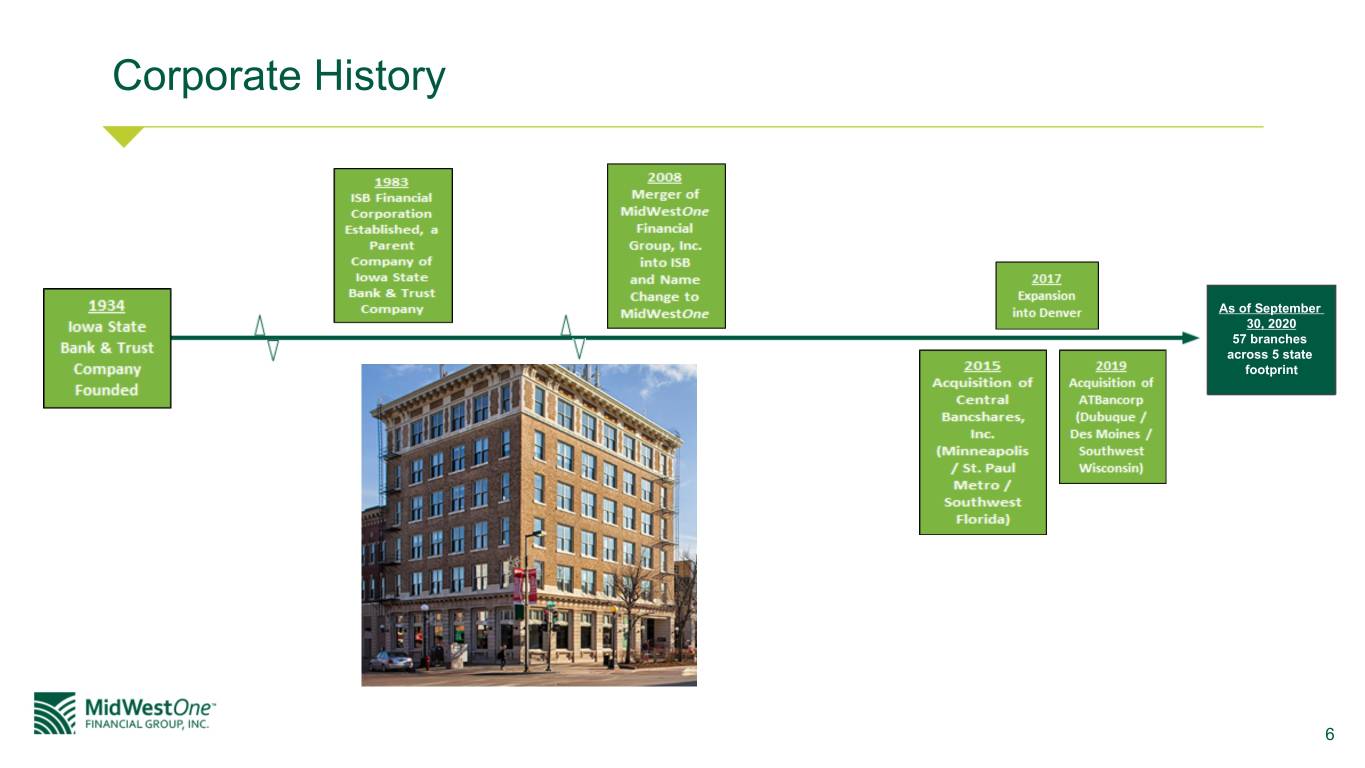
Corporate History As of September 30, 2020 57 branches across 5 state footprint 6
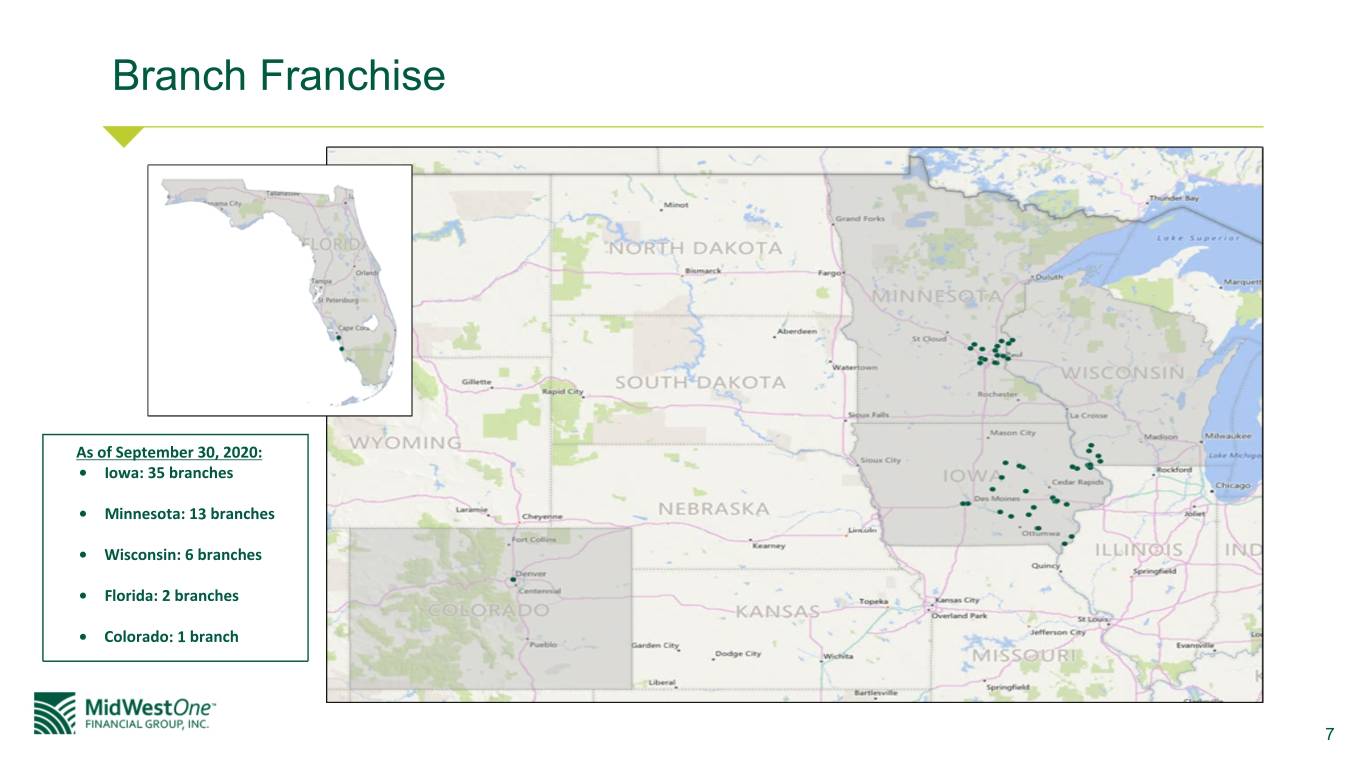
Branch Franchise As of September 30, 2020: • Iowa: 35 branches • Minnesota: 13 branches • Wisconsin: 6 branches • Florida: 2 branches • Colorado: 1 branch 7
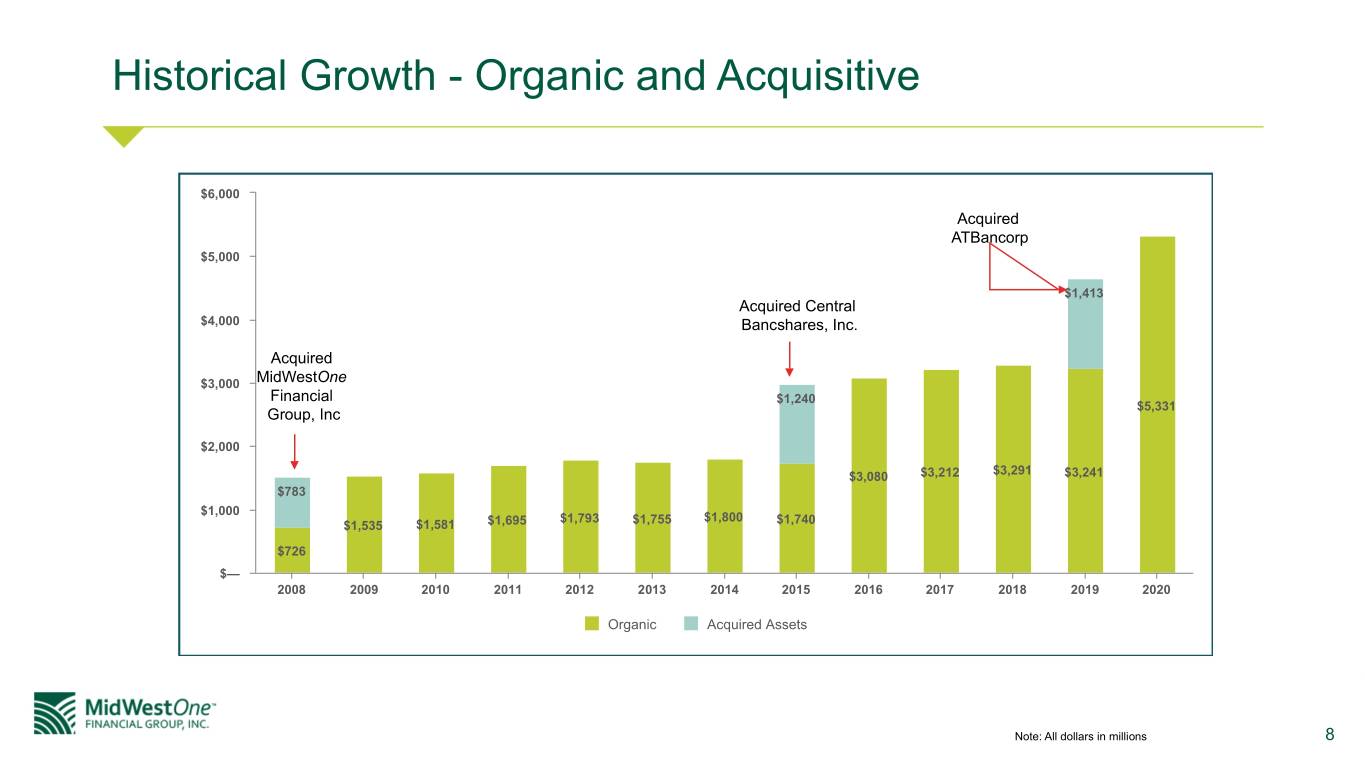
Historical Growth - Organic and Acquisitive $6,000 Acquired ATBancorp $5,000 $1,413 Acquired Central $4,000 Bancshares, Inc. Acquired $3,000 MidWestOne Financial $1,240 $5,331 Group, Inc $2,000 $3,080 $3,212 $3,291 $3,241 $783 $1,000 $1,793 $1,800 $1,535 $1,581 $1,695 $1,755 $1,740 $726 $— 2008 2009 2010 2011 2012 2013 2014 2015 2016 2017 2018 2019 2020 Organic Acquired Assets Note: All dollars in millions 8
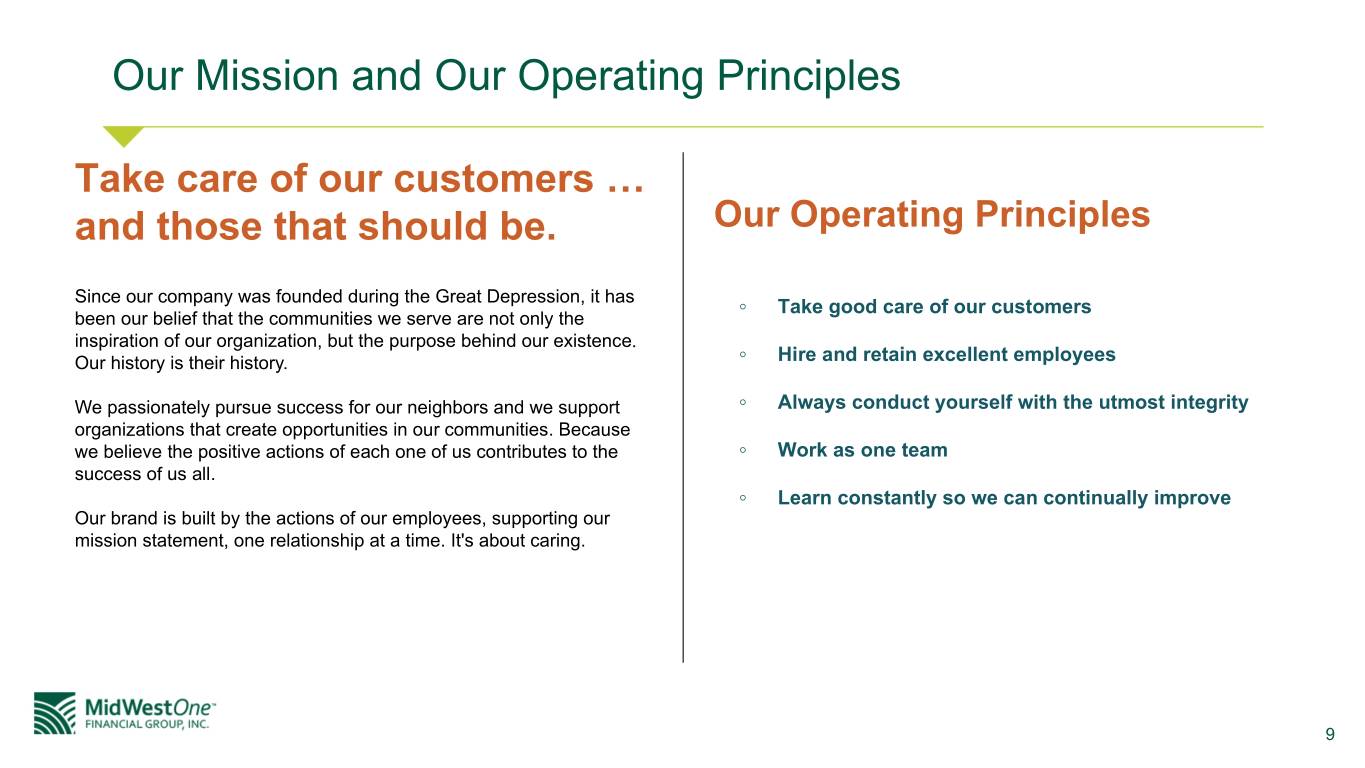
Our Mission and Our Operating Principles Take care of our customers … and those that should be. Our Operating Principles Since our company was founded during the Great Depression, it has ◦ Take good care of our customers been our belief that the communities we serve are not only the inspiration of our organization, but the purpose behind our existence. Our history is their history. ◦ Hire and retain excellent employees We passionately pursue success for our neighbors and we support ◦ Always conduct yourself with the utmost integrity organizations that create opportunities in our communities. Because we believe the positive actions of each one of us contributes to the ◦ Work as one team success of us all. ◦ Learn constantly so we can continually improve Our brand is built by the actions of our employees, supporting our mission statement, one relationship at a time. It's about caring. 9
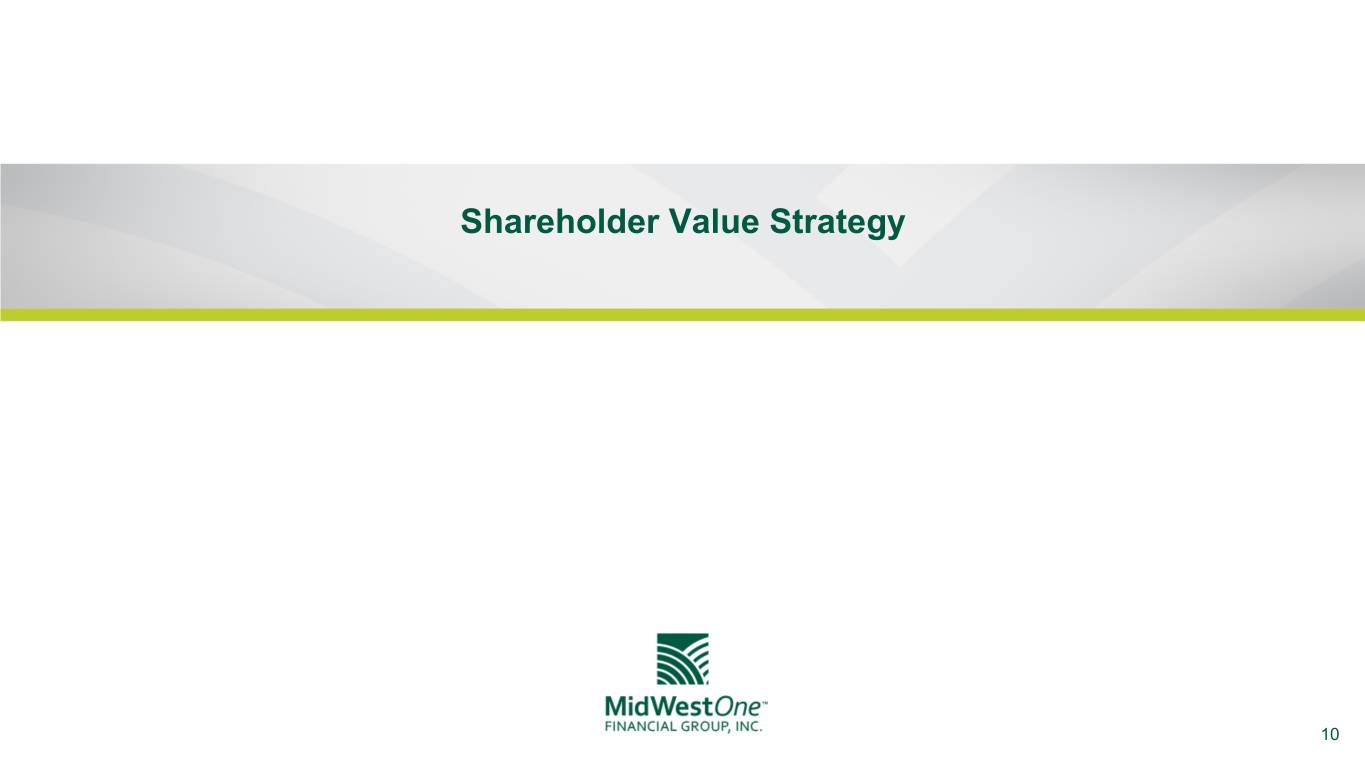
Shareholder Value Strategy 10
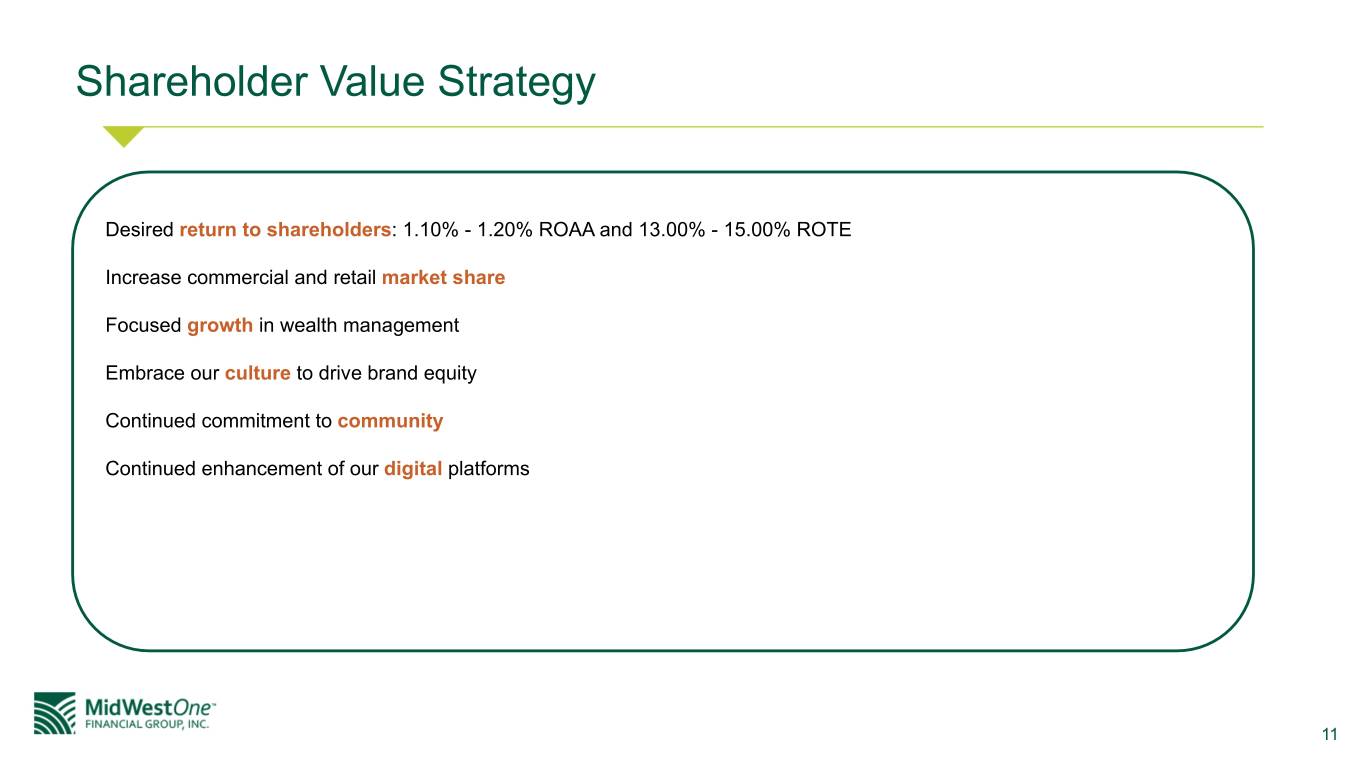
Shareholder Value Strategy Desired return to shareholders: 1.10% - 1.20% ROAA and 13.00% - 15.00% ROTE Increase commercial and retail market share Focused growth in wealth management Embrace our culture to drive brand equity Continued commitment to community Continued enhancement of our digital platforms 11
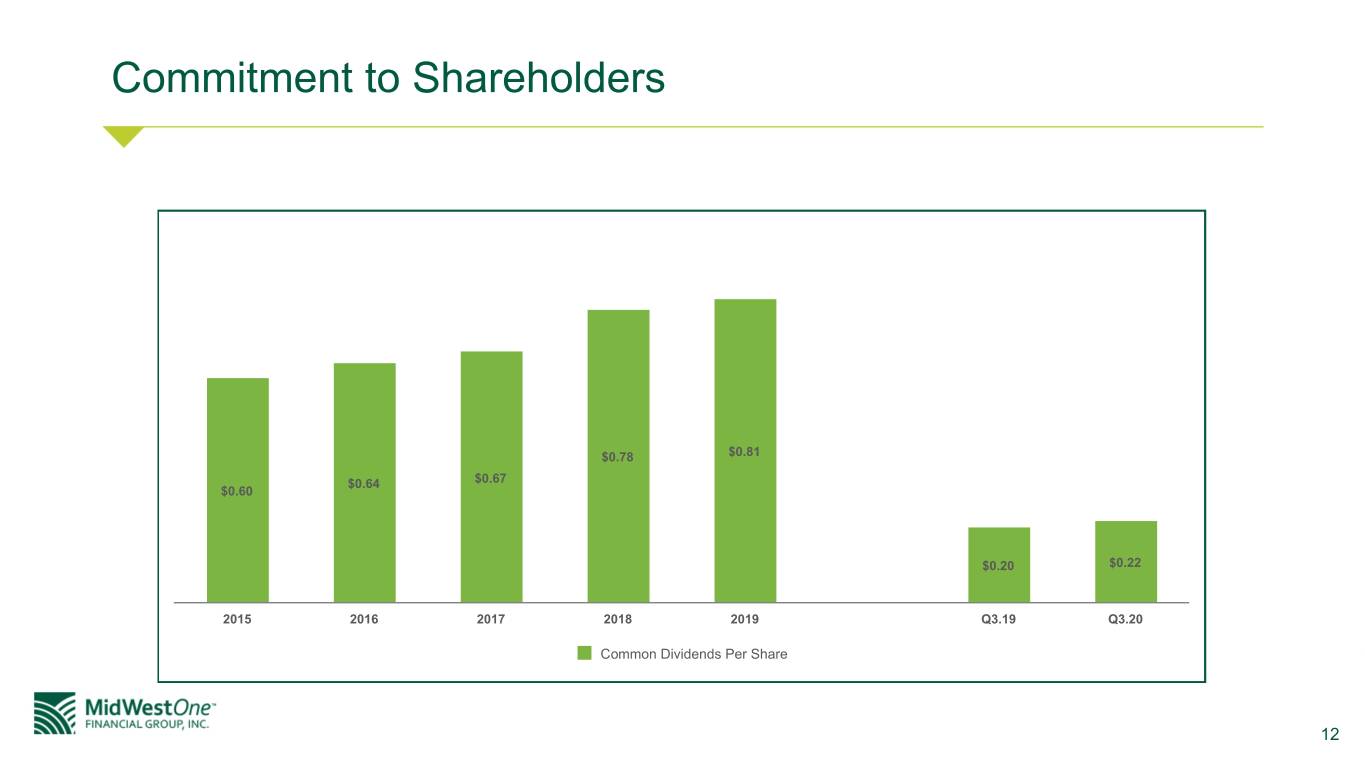
Commitment to Shareholders $0.78 $0.81 $0.64 $0.67 $0.60 $0.20 $0.22 2015 2016 2017 2018 2019 Q3.19 Q3.20 Common Dividends Per Share 12
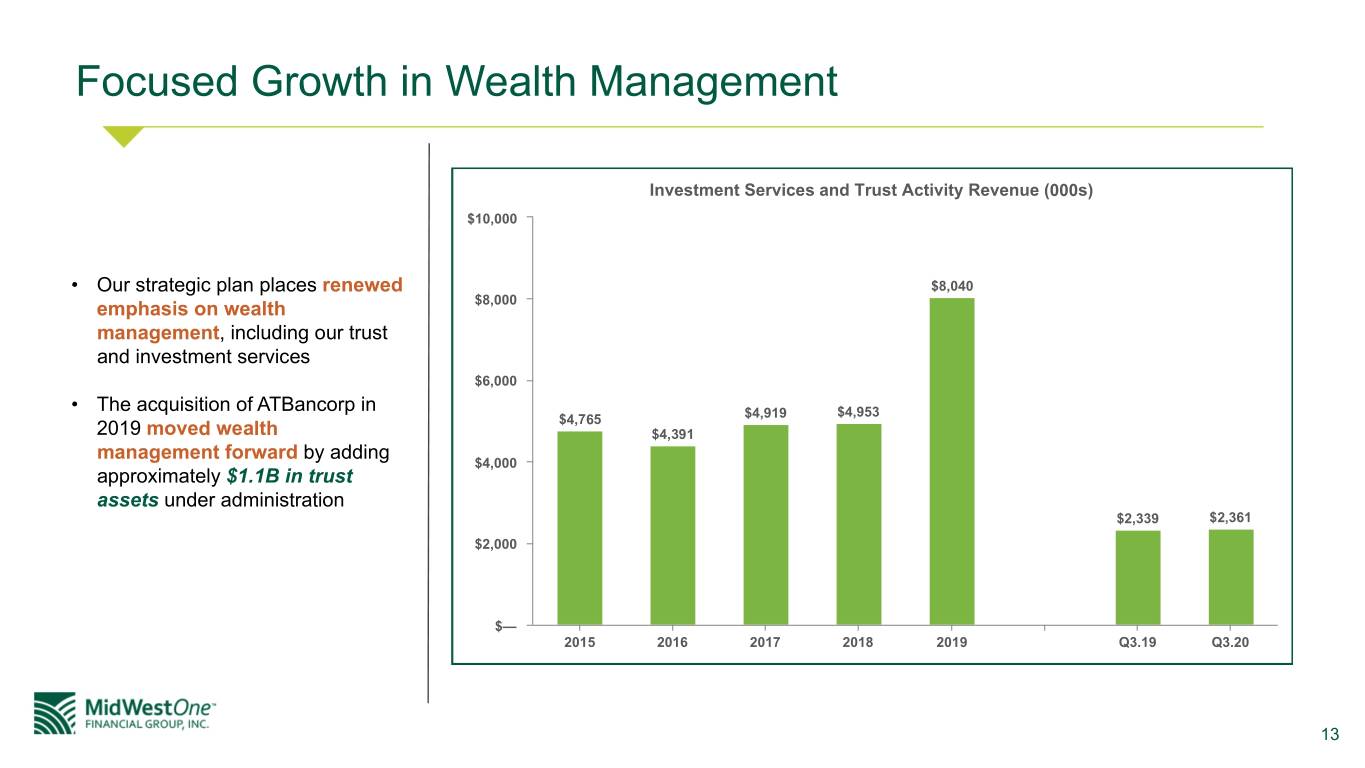
Focused Growth in Wealth Management Investment Services and Trust Activity Revenue (000s) $10,000 • Our strategic plan places renewed $8,040 emphasis on wealth $8,000 management, including our trust and investment services $6,000 • The acquisition of ATBancorp in $4,953 $4,765 $4,919 2019 moved wealth $4,391 management forward by adding $4,000 approximately $1.1B in trust assets under administration $2,339 $2,361 $2,000 $— 2015 2016 2017 2018 2019 Q3.19 Q3.20 13
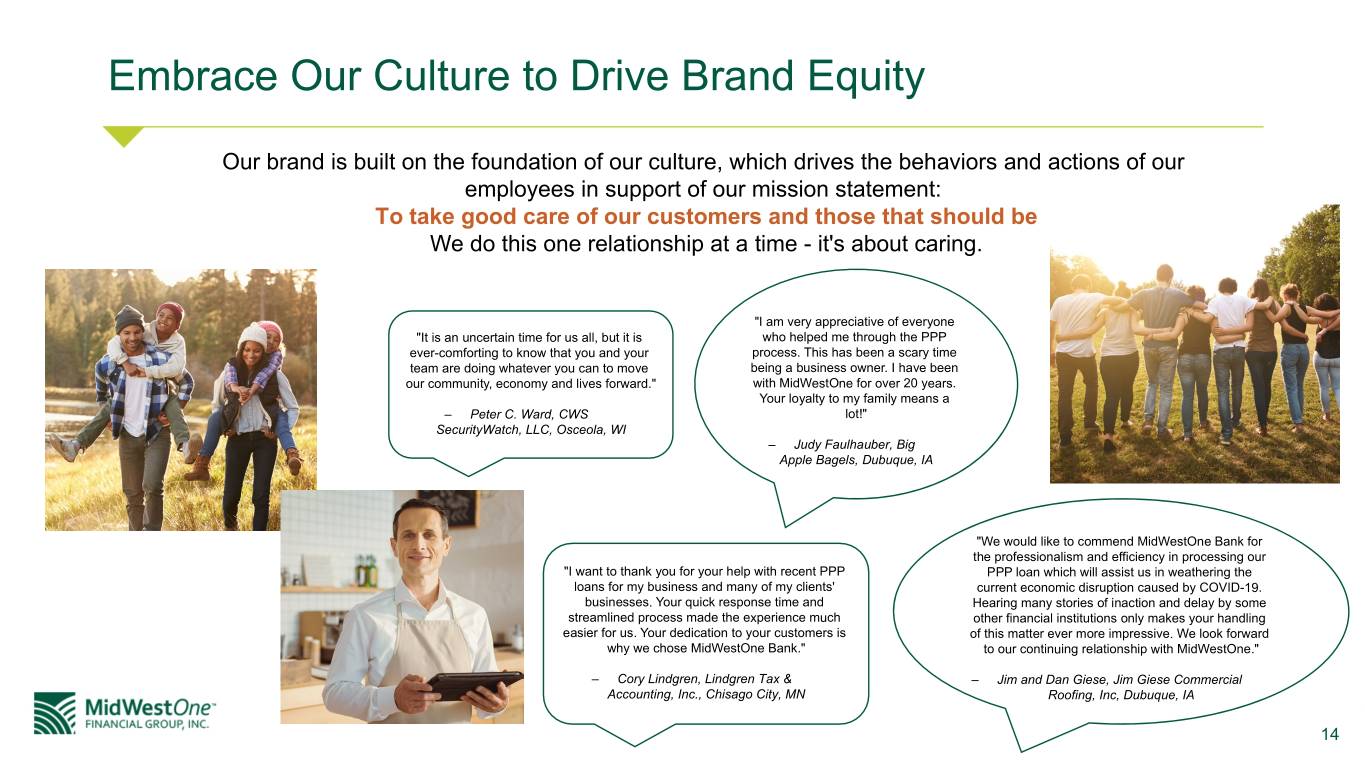
Embrace Our Culture to Drive Brand Equity Our brand is built on the foundation of our culture, which drives the behaviors and actions of our employees in support of our mission statement: To take good care of our customers and those that should be We do this one relationship at a time - it's about caring. "I am very appreciative of everyone "It is an uncertain time for us all, but it is who helped me through the PPP ever-comforting to know that you and your process. This has been a scary time team are doing whatever you can to move being a business owner. I have been our community, economy and lives forward." with MidWestOne for over 20 years. Your loyalty to my family means a – Peter C. Ward, CWS lot!" SecurityWatch, LLC, Osceola, WI – Judy Faulhauber, Big Apple Bagels, Dubuque, IA "We would like to commend MidWestOne Bank for the professionalism and efficiency in processing our "I want to thank you for your help with recent PPP PPP loan which will assist us in weathering the loans for my business and many of my clients' current economic disruption caused by COVID-19. businesses. Your quick response time and Hearing many stories of inaction and delay by some streamlined process made the experience much other financial institutions only makes your handling easier for us. Your dedication to your customers is of this matter ever more impressive. We look forward why we chose MidWestOne Bank." to our continuing relationship with MidWestOne." – Cory Lindgren, Lindgren Tax & – Jim and Dan Giese, Jim Giese Commercial Accounting, Inc., Chisago City, MN Roofing, Inc, Dubuque, IA 14
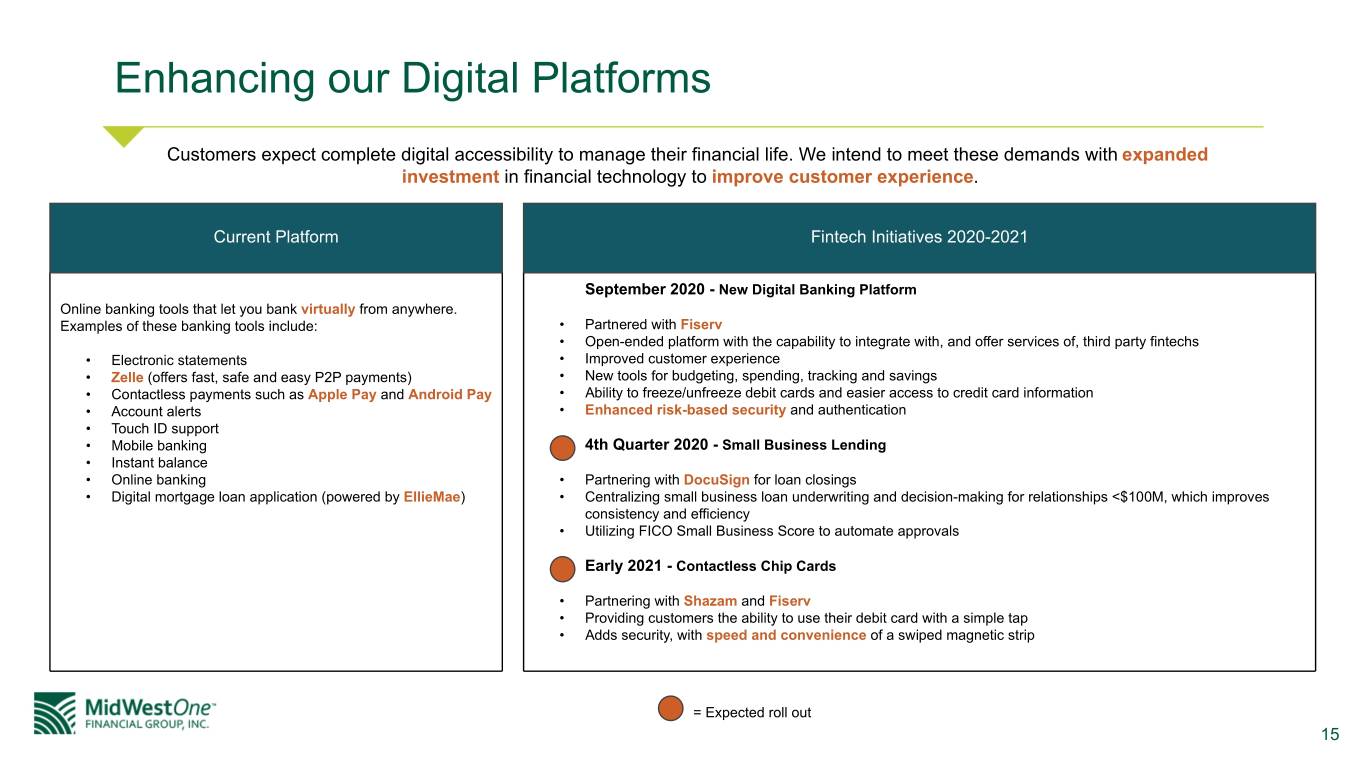
Enhancing our Digital Platforms Customers expect complete digital accessibility to manage their financial life. We intend to meet these demands with expanded investment in financial technology to improve customer experience. Current Platform Fintech Initiatives 2020-2021 September 2020 - New Digital Banking Platform Online banking tools that let you bank virtually from anywhere. Examples of these banking tools include: • Partnered with Fiserv • Open-ended platform with the capability to integrate with, and offer services of, third party fintechs • Electronic statements • Improved customer experience • Zelle (offers fast, safe and easy P2P payments) • New tools for budgeting, spending, tracking and savings • Contactless payments such as Apple Pay and Android Pay • Ability to freeze/unfreeze debit cards and easier access to credit card information • Account alerts • Enhanced risk-based security and authentication • Touch ID support • Mobile banking 4th Quarter 2020 - Small Business Lending • Instant balance • Online banking • Partnering with DocuSign for loan closings • Digital mortgage loan application (powered by EllieMae) • Centralizing small business loan underwriting and decision-making for relationships <$100M, which improves consistency and efficiency • Utilizing FICO Small Business Score to automate approvals Early 2021 - Contactless Chip Cards • Partnering with Shazam and Fiserv • Providing customers the ability to use their debit card with a simple tap • Adds security, with speed and convenience of a swiped magnetic strip = Expected roll out 15
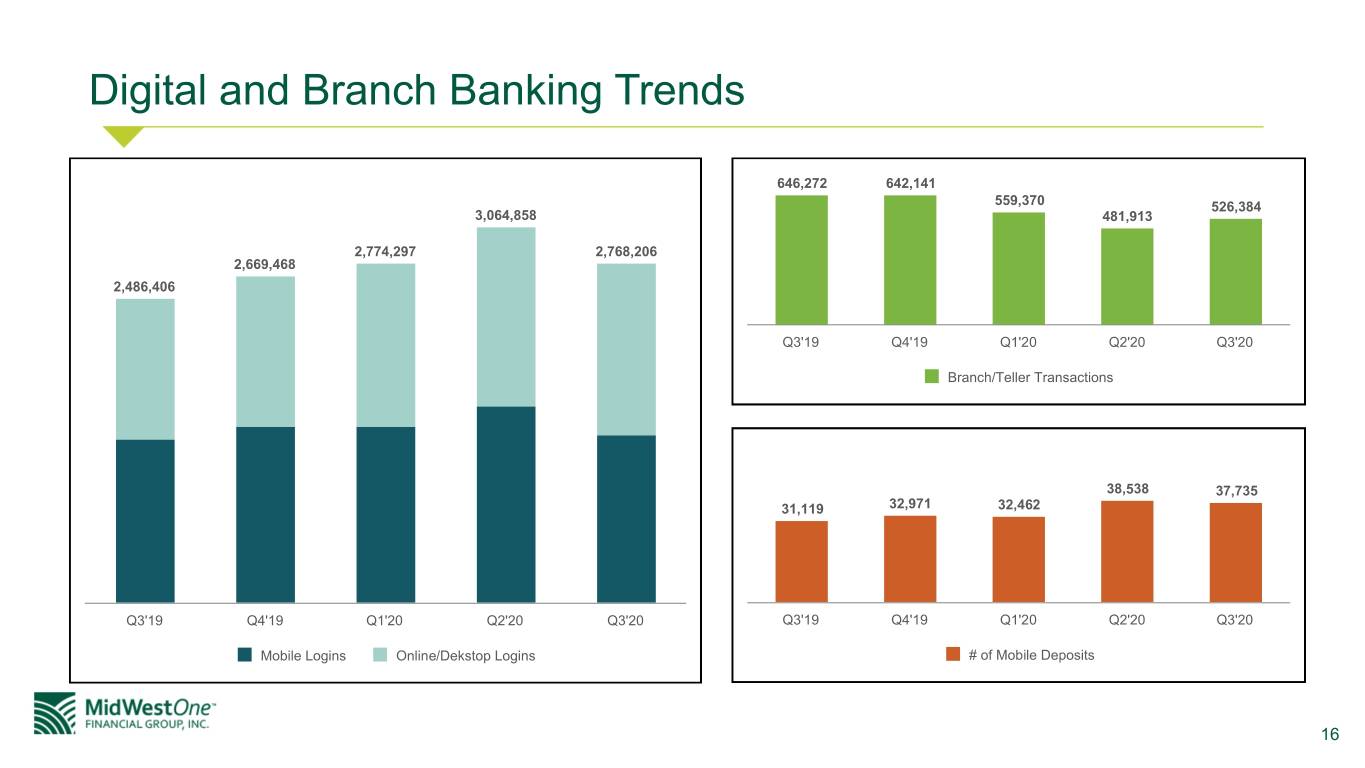
Digital and Branch Banking Trends 646,272 642,141 559,370 526,384 3,064,858 481,913 2,774,297 2,768,206 2,669,468 2,486,406 Q3'19 Q4'19 Q1'20 Q2'20 Q3'20 Branch/Teller Transactions 38,538 37,735 31,119 32,971 32,462 Q3'19 Q4'19 Q1'20 Q2'20 Q3'20 Q3'19 Q4'19 Q1'20 Q2'20 Q3'20 Mobile Logins Online/Dekstop Logins # of Mobile Deposits 16
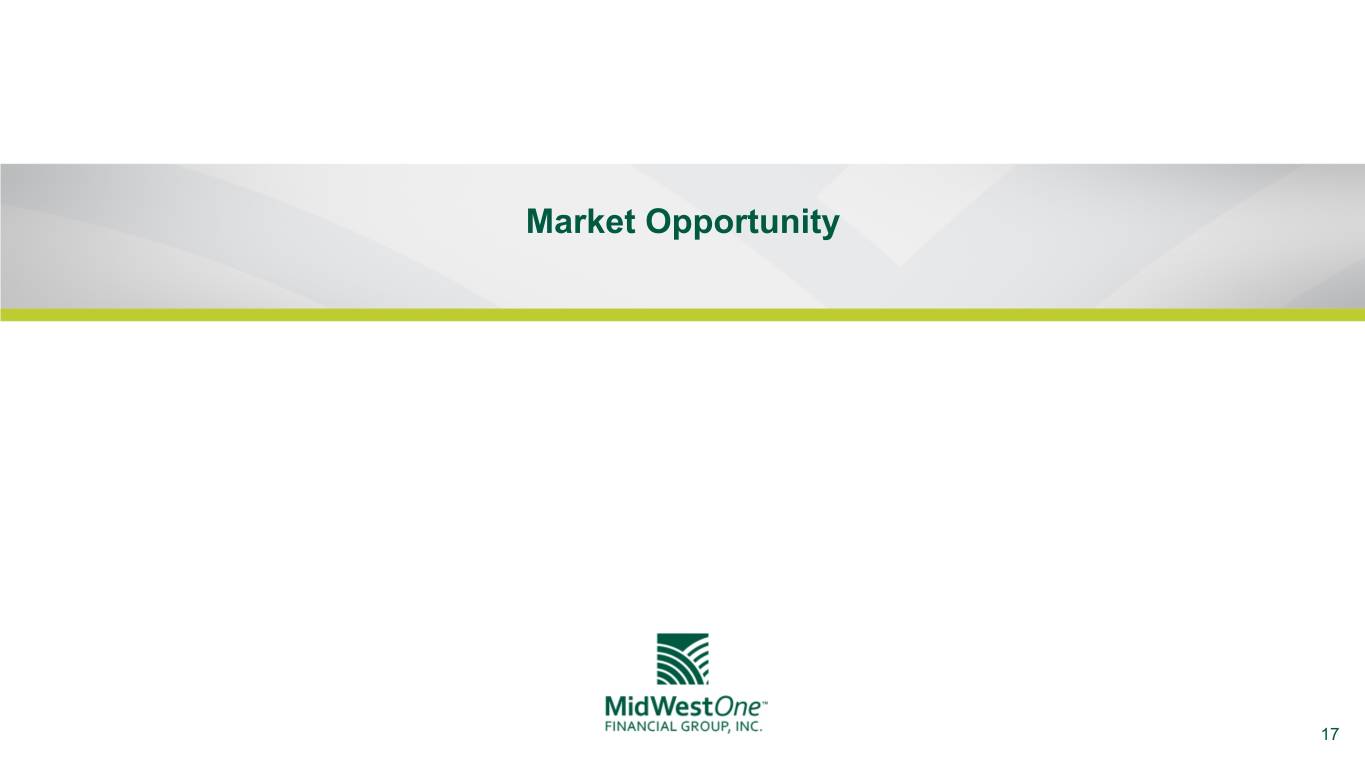
Market Opportunity 17
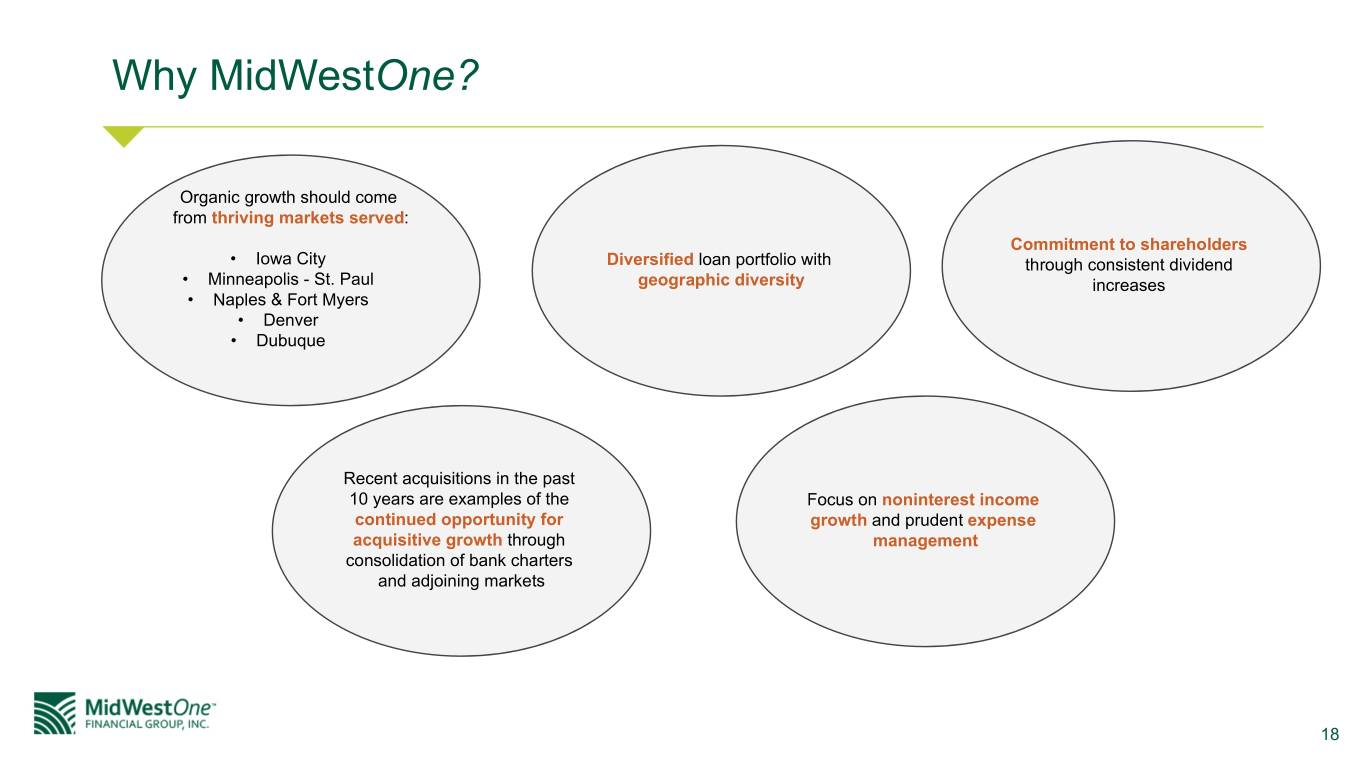
Why MidWestOne? Organic growth should come from thriving markets served: Commitment to shareholders • Iowa City Diversified loan portfolio with through consistent dividend • Minneapolis - St. Paul geographic diversity increases • Naples & Fort Myers • Denver • Dubuque Recent acquisitions in the past 10 years are examples of the Focus on noninterest income continued opportunity for growth and prudent expense acquisitive growth through management consolidation of bank charters and adjoining markets 18
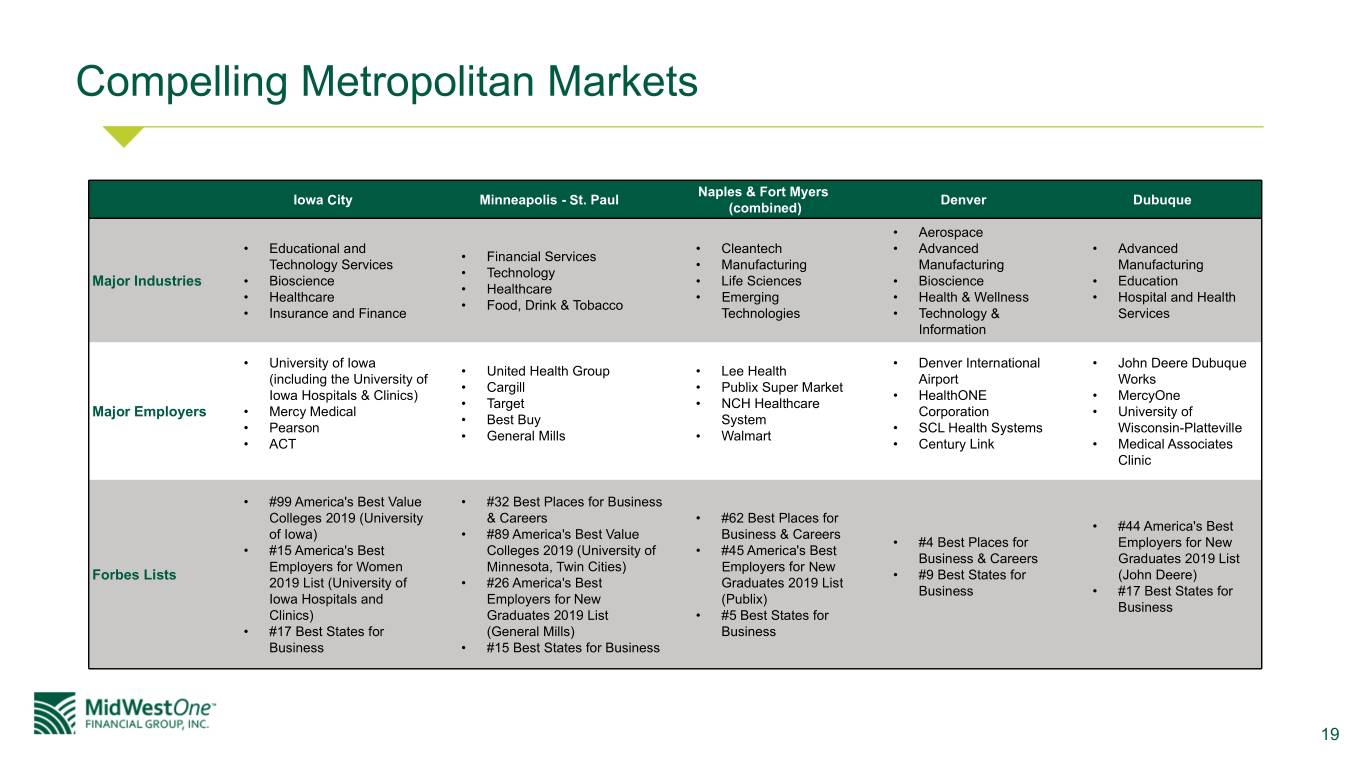
Compelling Metropolitan Markets Naples & Fort Myers Iowa City Minneapolis - St. Paul Denver Dubuque (combined) • Aerospace • Educational and • Cleantech • Advanced • Advanced • Financial Services Technology Services • Manufacturing Manufacturing Manufacturing • Technology Major Industries • Bioscience • Life Sciences • Bioscience • Education • Healthcare • Healthcare • Emerging • Health & Wellness • Hospital and Health • Food, Drink & Tobacco • Insurance and Finance Technologies • Technology & Services Information • University of Iowa • Denver International • John Deere Dubuque • United Health Group • Lee Health (including the University of Airport Works • Cargill • Publix Super Market Iowa Hospitals & Clinics) • HealthONE • MercyOne • Target • NCH Healthcare Major Employers • Mercy Medical Corporation • University of • Best Buy System • Pearson • SCL Health Systems Wisconsin-Platteville • General Mills • Walmart • ACT • Century Link • Medical Associates Clinic • #99 America's Best Value • #32 Best Places for Business Colleges 2019 (University & Careers • #62 Best Places for • #44 America's Best of Iowa) • #89 America's Best Value Business & Careers • #4 Best Places for Employers for New • #15 America's Best Colleges 2019 (University of • #45 America's Best Business & Careers Graduates 2019 List Employers for Women Minnesota, Twin Cities) Employers for New Forbes Lists • #9 Best States for (John Deere) 2019 List (University of • #26 America's Best Graduates 2019 List Business • #17 Best States for Iowa Hospitals and Employers for New (Publix) Business Clinics) Graduates 2019 List • #5 Best States for • #17 Best States for (General Mills) Business Business • #15 Best States for Business 19
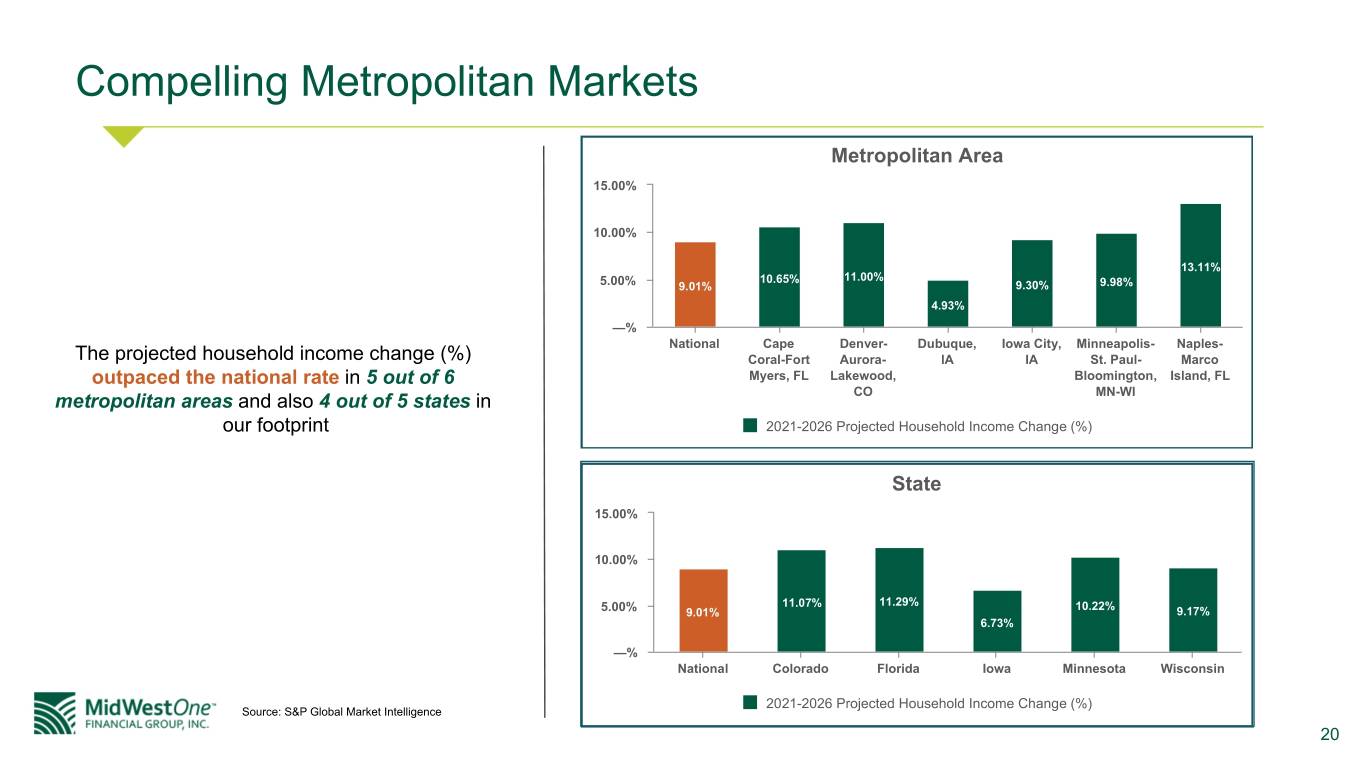
Compelling Metropolitan Markets Metropolitan Area 15.00% 10.00% 13.11% 10.65% 11.00% 5.00% 9.01% 9.30% 9.98% 4.93% —% The projected household income change (%) National Cape Denver- Dubuque, Iowa City, Minneapolis- Naples- Coral-Fort Aurora- IA IA St. Paul- Marco outpaced the national rate in 5 out of 6 Myers, FL Lakewood, Bloomington, Island, FL metropolitan areas and also 4 out of 5 states in CO MN-WI our footprint 2021-2026 Projected Household Income Change (%) State 15.00% 10.00% 11.07% 11.29% 10.22% 5.00% 9.01% 9.17% 6.73% —% National Colorado Florida Iowa Minnesota Wisconsin 2021-2026 Projected Household Income Change (%) Source: S&P Global Market Intelligence 20
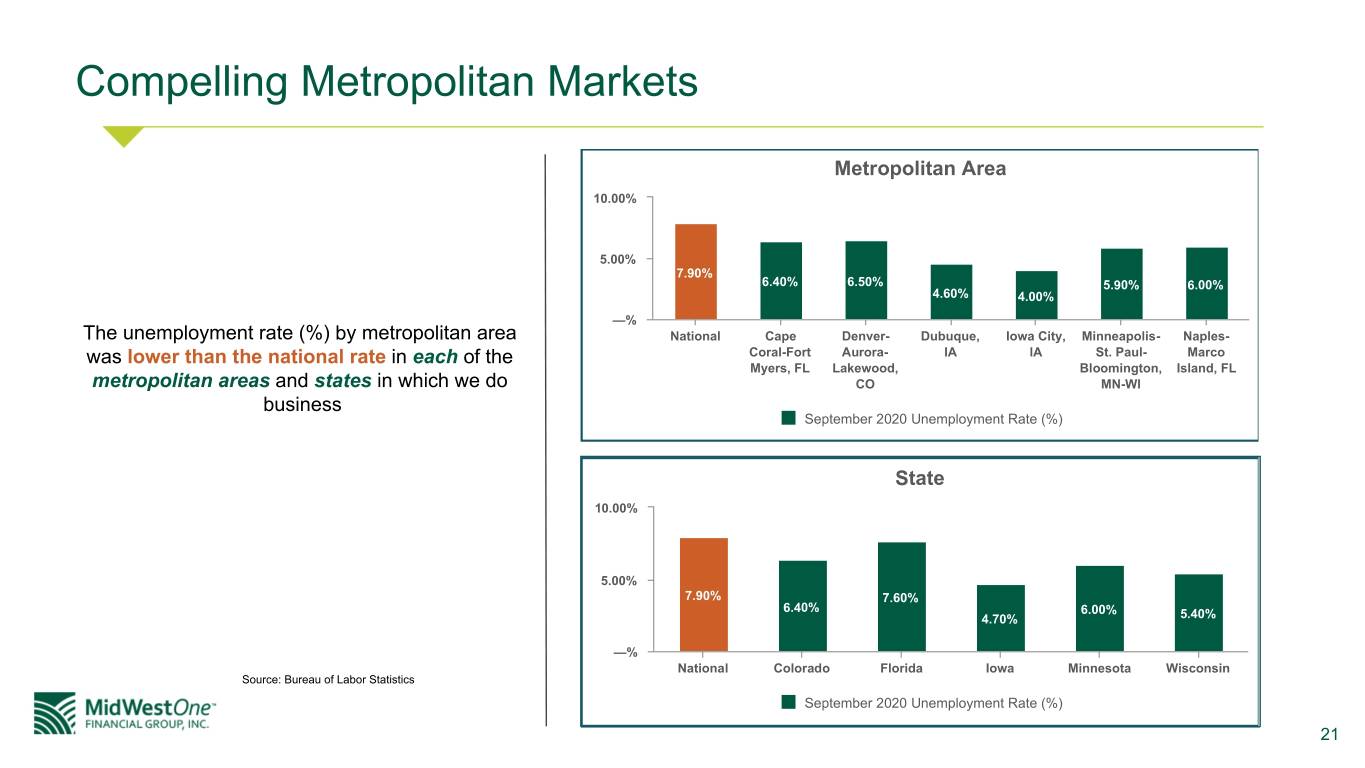
Compelling Metropolitan Markets Metropolitan Area 10.00% 5.00% 7.90% 6.40% 6.50% 5.90% 6.00% 4.60% 4.00% —% The unemployment rate (%) by metropolitan area National Cape Denver- Dubuque, Iowa City, Minneapolis- Naples- was lower than the national rate in each of the Coral-Fort Aurora- IA IA St. Paul- Marco Myers, FL Lakewood, Bloomington, Island, FL metropolitan areas and states in which we do CO MN-WI business September 2020 Unemployment Rate (%) State 10.00% 5.00% 7.90% 7.60% 6.40% 6.00% 4.70% 5.40% —% National Colorado Florida Iowa Minnesota Wisconsin Source: Bureau of Labor Statistics September 2020 Unemployment Rate (%) 21
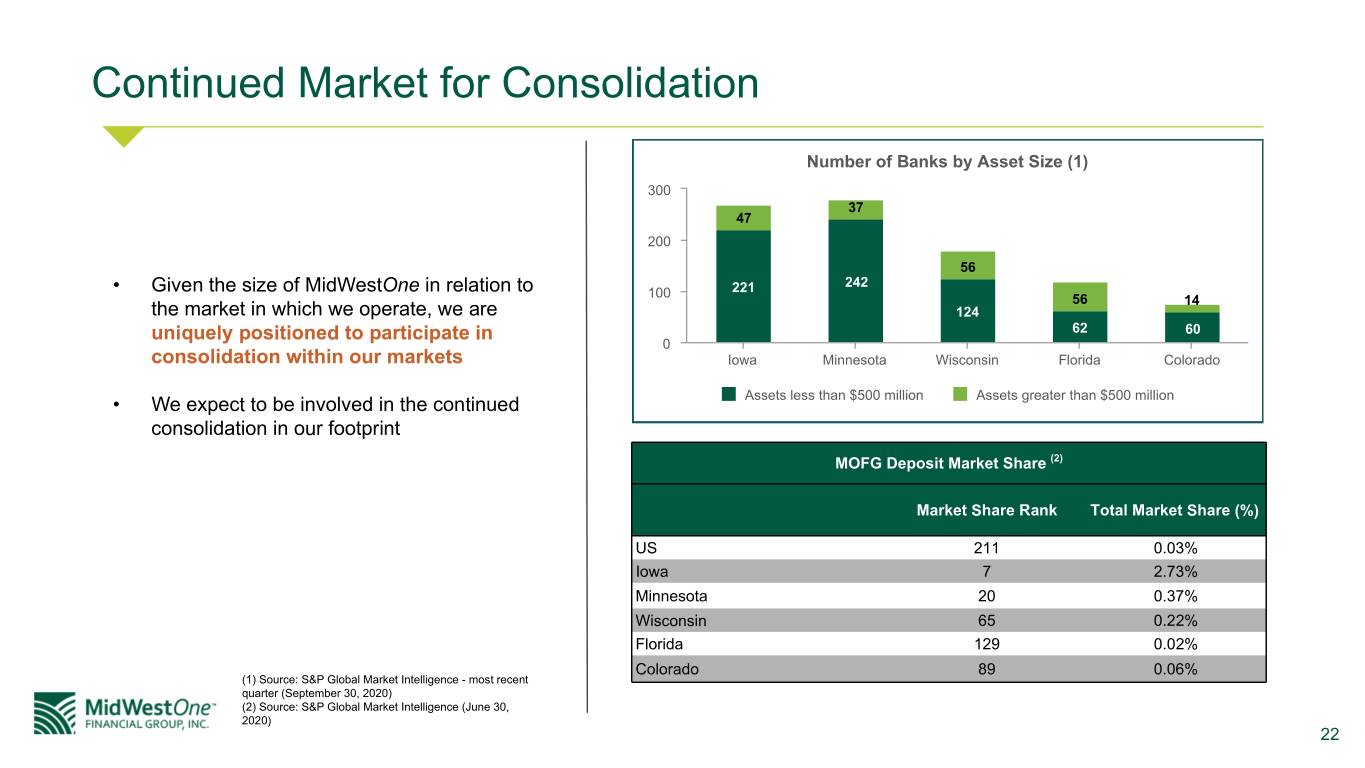
Continued Market for Consolidation Number of Banks by Asset Size (1) 300 37 47 200 56 242 • Given the size of MidWestOne in relation to 100 221 56 14 the market in which we operate, we are 124 uniquely positioned to participate in 62 60 0 consolidation within our markets Iowa Minnesota Wisconsin Florida Colorado • We expect to be involved in the continued Assets less than $500 million Assets greater than $500 million consolidation in our footprint MOFG Deposit Market Share (2) Market Share Rank Total Market Share (%) US 211 0.03% Iowa 7 2.73% Minnesota 20 0.37% Wisconsin 65 0.22% Florida 129 0.02% Colorado 89 0.06% (1) Source: S&P Global Market Intelligence - most recent quarter (September 30, 2020) (2) Source: S&P Global Market Intelligence (June 30, 2020) 22
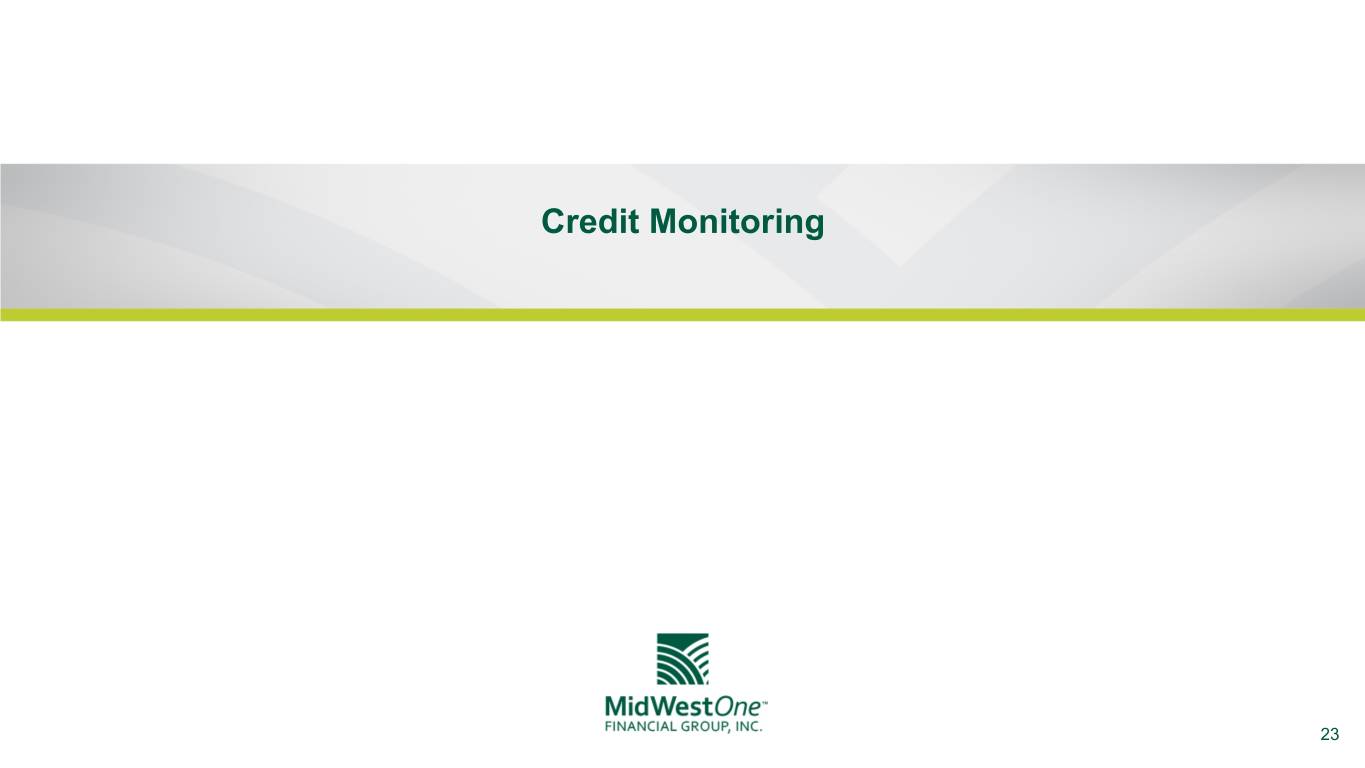
Credit Monitoring 23
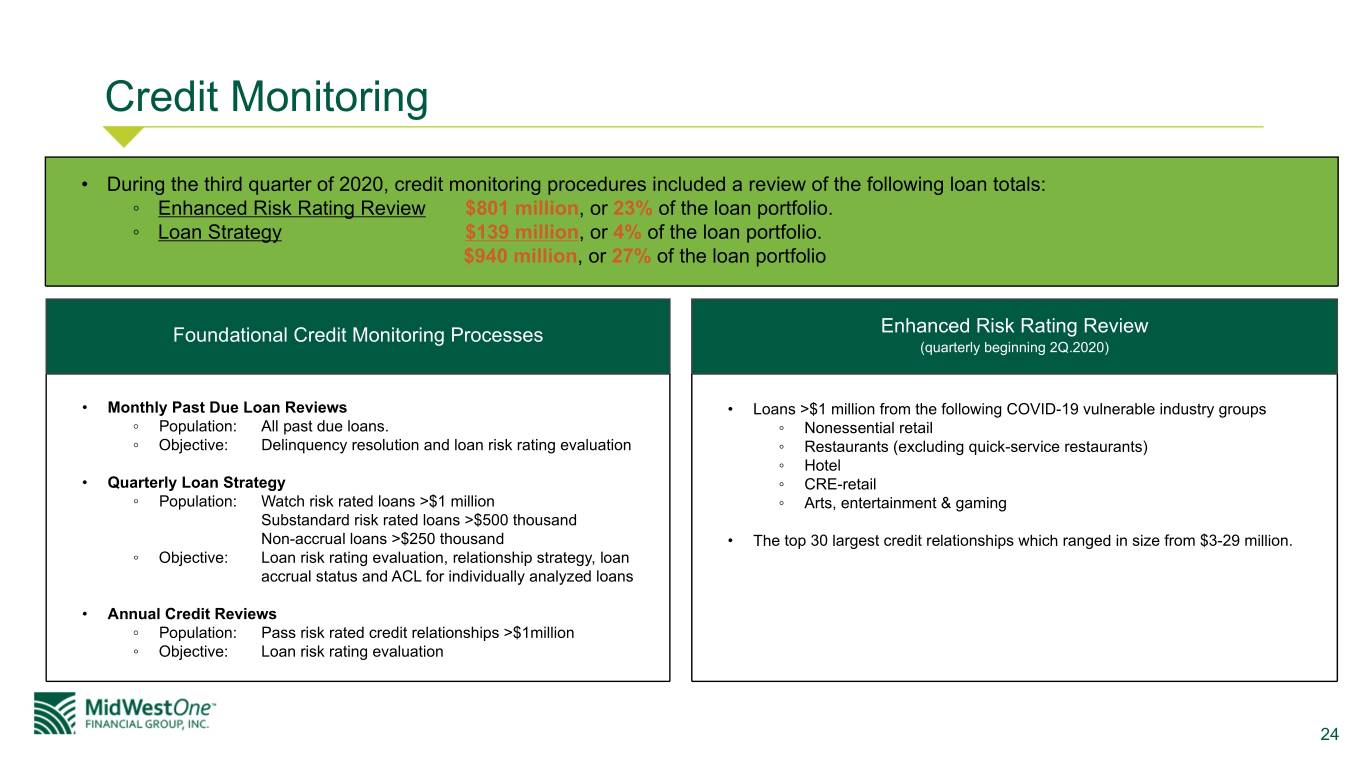
Credit Monitoring • During the third quarter of 2020, credit monitoring procedures included a review of the following loan totals: ◦ Enhanced Risk Rating Review $801 million, or 23% of the loan portfolio. ◦ Loan Strategy $139 million, or 4% of the loan portfolio. $940 million, or 27% of the loan portfolio Foundational Credit Monitoring Processes Enhanced Risk Rating Review (quarterly beginning 2Q.2020) • Monthly Past Due Loan Reviews • Loans >$1 million from the following COVID-19 vulnerable industry groups ◦ Population: All past due loans. ◦ Nonessential retail ◦ Objective: Delinquency resolution and loan risk rating evaluation ◦ Restaurants (excluding quick-service restaurants) ◦ Hotel • Quarterly Loan Strategy ◦ CRE-retail ◦ Population: Watch risk rated loans >$1 million ◦ Arts, entertainment & gaming Substandard risk rated loans >$500 thousand Non-accrual loans >$250 thousand • The top 30 largest credit relationships which ranged in size from $3-29 million. ◦ Objective: Loan risk rating evaluation, relationship strategy, loan accrual status and ACL for individually analyzed loans • Annual Credit Reviews ◦ Population: Pass risk rated credit relationships >$1million ◦ Objective: Loan risk rating evaluation 24
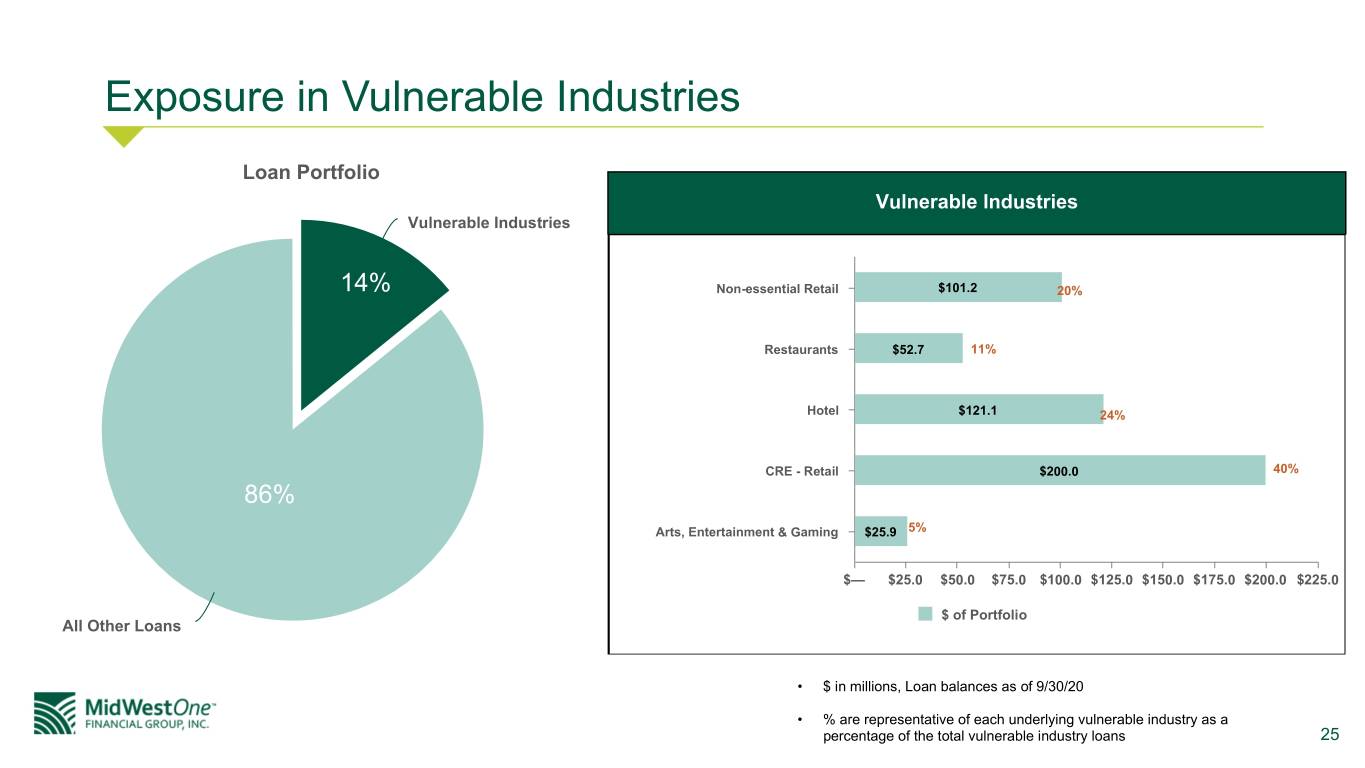
Exposure in Vulnerable Industries Loan Portfolio Vulnerable Industries Vulnerable Industries 14% Non-essential Retail $101.2 20% Restaurants $52.7 11% Hotel $121.1 24% CRE - Retail $200.0 40% 86% Arts, Entertainment & Gaming $25.9 5% $— $25.0 $50.0 $75.0 $100.0 $125.0 $150.0 $175.0 $200.0 $225.0 $ of Portfolio All Other Loans • $ in millions, Loan balances as of 9/30/20 • % are representative of each underlying vulnerable industry as a percentage of the total vulnerable industry loans 25
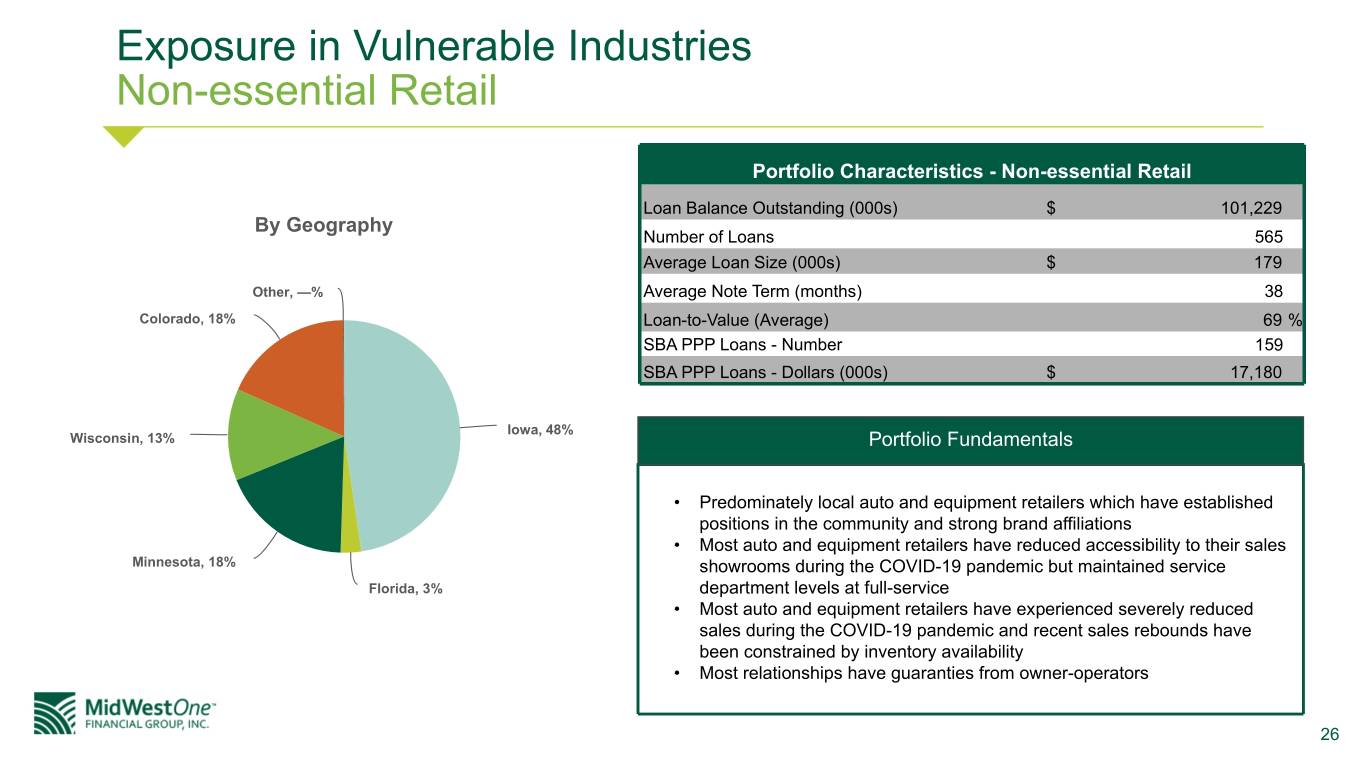
Exposure in Vulnerable Industries Non-essential Retail Portfolio Characteristics - Non-essential Retail Loan Balance Outstanding (000s) $ 101,229 By Geography Number of Loans 565 Average Loan Size (000s) $ 179 Other, —% Average Note Term (months) 38 Colorado, 18% Loan-to-Value (Average) 69 % SBA PPP Loans - Number 159 SBA PPP Loans - Dollars (000s) $ 17,180 Iowa, 48% Wisconsin, 13% Portfolio Fundamentals • Predominately local auto and equipment retailers which have established positions in the community and strong brand affiliations • Most auto and equipment retailers have reduced accessibility to their sales Minnesota, 18% showrooms during the COVID-19 pandemic but maintained service Florida, 3% department levels at full-service • Most auto and equipment retailers have experienced severely reduced sales during the COVID-19 pandemic and recent sales rebounds have been constrained by inventory availability • Most relationships have guaranties from owner-operators 26
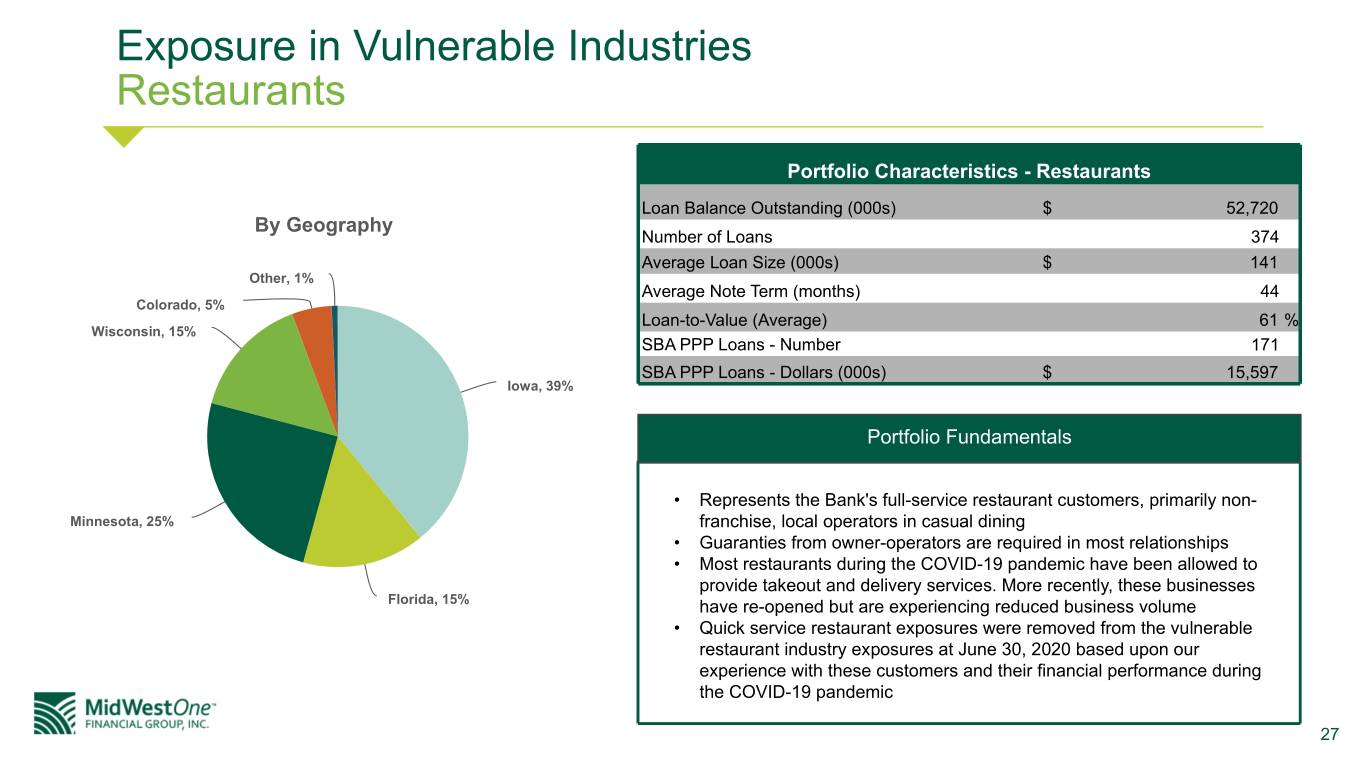
Exposure in Vulnerable Industries Restaurants Portfolio Characteristics - Restaurants Loan Balance Outstanding (000s) $ 52,720 By Geography Number of Loans 374 Average Loan Size (000s) $ 141 Other, 1% Average Note Term (months) 44 Colorado, 5% Loan-to-Value (Average) 61 % Wisconsin, 15% SBA PPP Loans - Number 171 SBA PPP Loans - Dollars (000s) $ 15,597 Iowa, 39% Portfolio Fundamentals • Represents the Bank's full-service restaurant customers, primarily non- Minnesota, 25% franchise, local operators in casual dining • Guaranties from owner-operators are required in most relationships • Most restaurants during the COVID-19 pandemic have been allowed to provide takeout and delivery services. More recently, these businesses Florida, 15% have re-opened but are experiencing reduced business volume • Quick service restaurant exposures were removed from the vulnerable restaurant industry exposures at June 30, 2020 based upon our experience with these customers and their financial performance during the COVID-19 pandemic 27
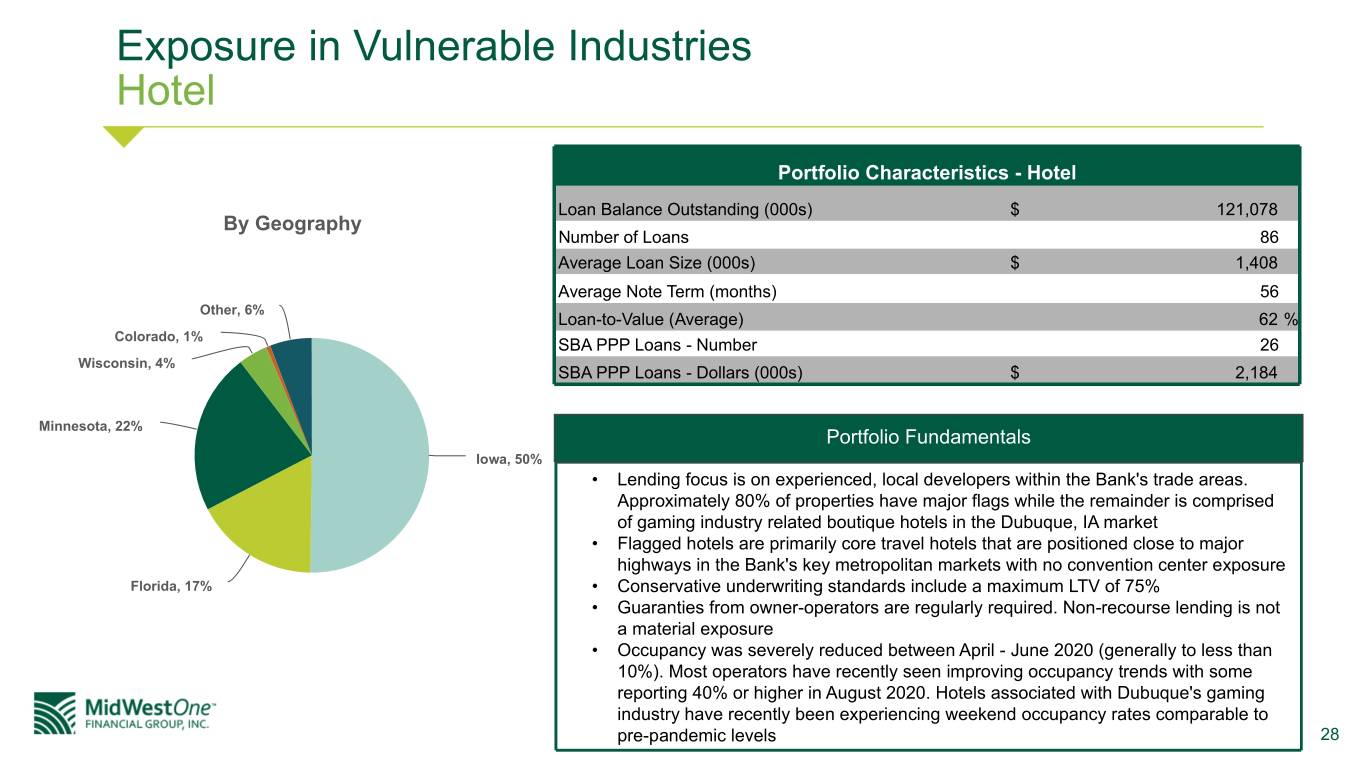
Exposure in Vulnerable Industries Hotel Portfolio Characteristics - Hotel Loan Balance Outstanding (000s) $ 121,078 By Geography Number of Loans 86 Average Loan Size (000s) $ 1,408 Average Note Term (months) 56 Other, 6% Loan-to-Value (Average) 62 % Colorado, 1% SBA PPP Loans - Number 26 Wisconsin, 4% SBA PPP Loans - Dollars (000s) $ 2,184 Minnesota, 22% Portfolio Fundamentals Iowa, 50% • Lending focus is on experienced, local developers within the Bank's trade areas. Approximately 80% of properties have major flags while the remainder is comprised of gaming industry related boutique hotels in the Dubuque, IA market • Flagged hotels are primarily core travel hotels that are positioned close to major highways in the Bank's key metropolitan markets with no convention center exposure Florida, 17% • Conservative underwriting standards include a maximum LTV of 75% • Guaranties from owner-operators are regularly required. Non-recourse lending is not a material exposure • Occupancy was severely reduced between April - June 2020 (generally to less than 10%). Most operators have recently seen improving occupancy trends with some reporting 40% or higher in August 2020. Hotels associated with Dubuque's gaming industry have recently been experiencing weekend occupancy rates comparable to pre-pandemic levels 28
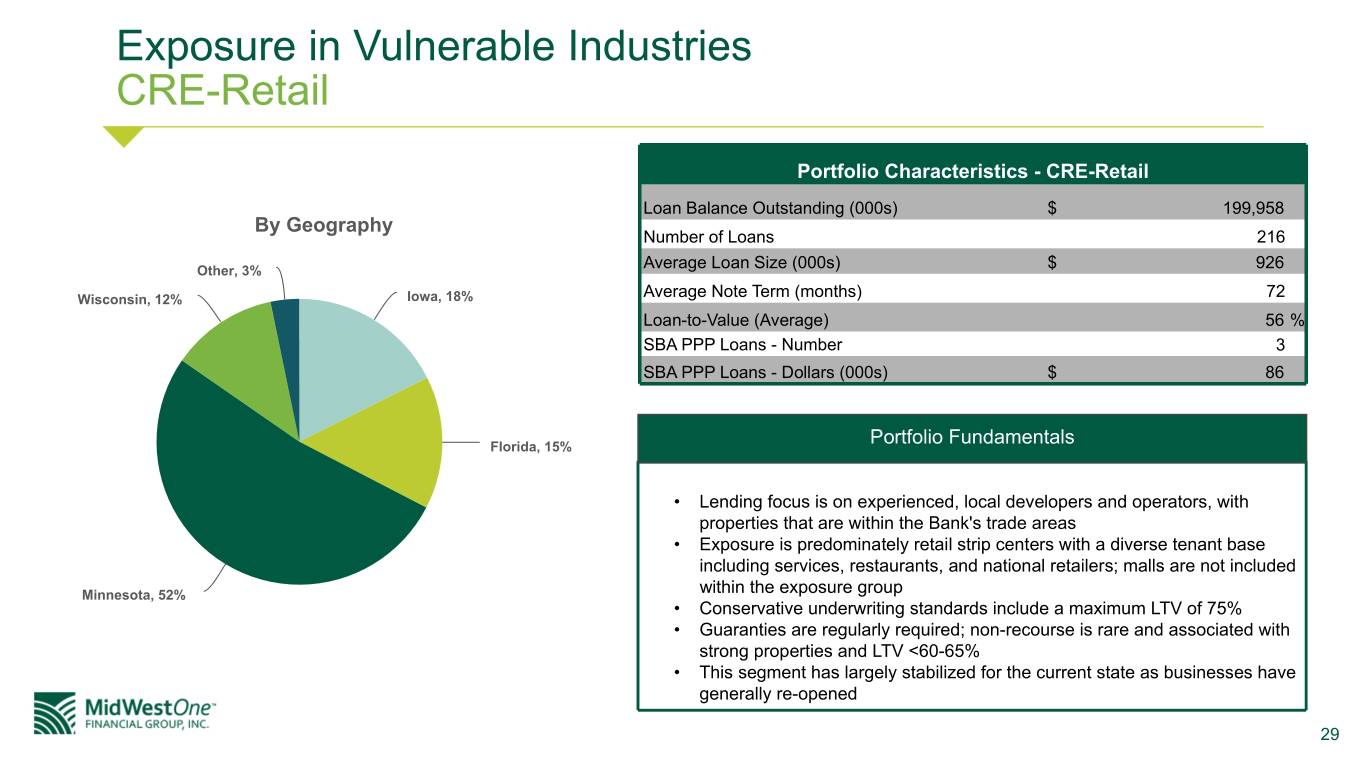
Exposure in Vulnerable Industries CRE-Retail Portfolio Characteristics - CRE-Retail Loan Balance Outstanding (000s) $ 199,958 By Geography Number of Loans 216 Other, 3% Average Loan Size (000s) $ 926 Wisconsin, 12% Iowa, 18% Average Note Term (months) 72 Loan-to-Value (Average) 56 % SBA PPP Loans - Number 3 SBA PPP Loans - Dollars (000s) $ 86 Florida, 15% Portfolio Fundamentals • Lending focus is on experienced, local developers and operators, with properties that are within the Bank's trade areas • Exposure is predominately retail strip centers with a diverse tenant base including services, restaurants, and national retailers; malls are not included Minnesota, 52% within the exposure group • Conservative underwriting standards include a maximum LTV of 75% • Guaranties are regularly required; non-recourse is rare and associated with strong properties and LTV <60-65% • This segment has largely stabilized for the current state as businesses have generally re-opened 29
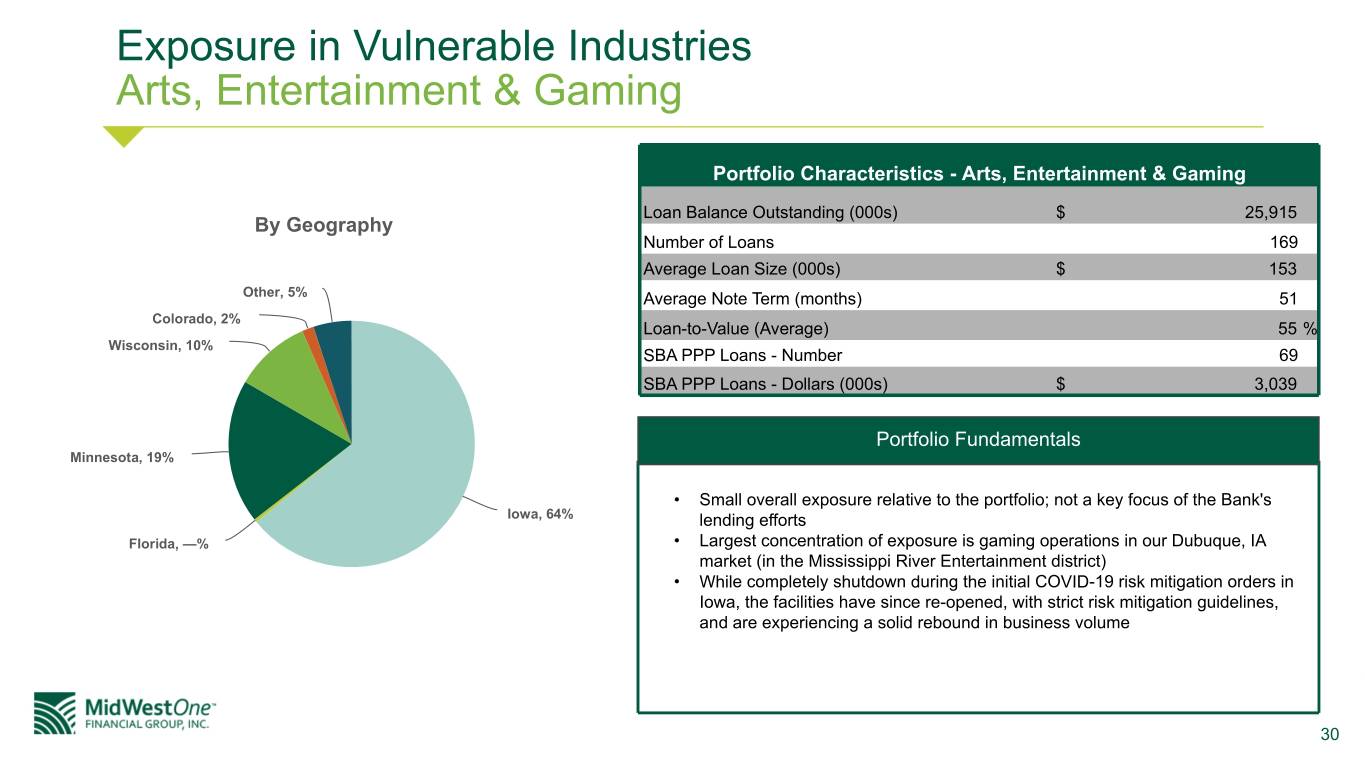
Exposure in Vulnerable Industries Arts, Entertainment & Gaming Portfolio Characteristics - Arts, Entertainment & Gaming Loan Balance Outstanding (000s) $ 25,915 By Geography Number of Loans 169 Average Loan Size (000s) $ 153 Other, 5% Average Note Term (months) 51 Colorado, 2% Loan-to-Value (Average) 55 % Wisconsin, 10% SBA PPP Loans - Number 69 SBA PPP Loans - Dollars (000s) $ 3,039 Portfolio Fundamentals Minnesota, 19% • Small overall exposure relative to the portfolio; not a key focus of the Bank's Iowa, 64% lending efforts Florida, —% • Largest concentration of exposure is gaming operations in our Dubuque, IA market (in the Mississippi River Entertainment district) • While completely shutdown during the initial COVID-19 risk mitigation orders in Iowa, the facilities have since re-opened, with strict risk mitigation guidelines, and are experiencing a solid rebound in business volume 30
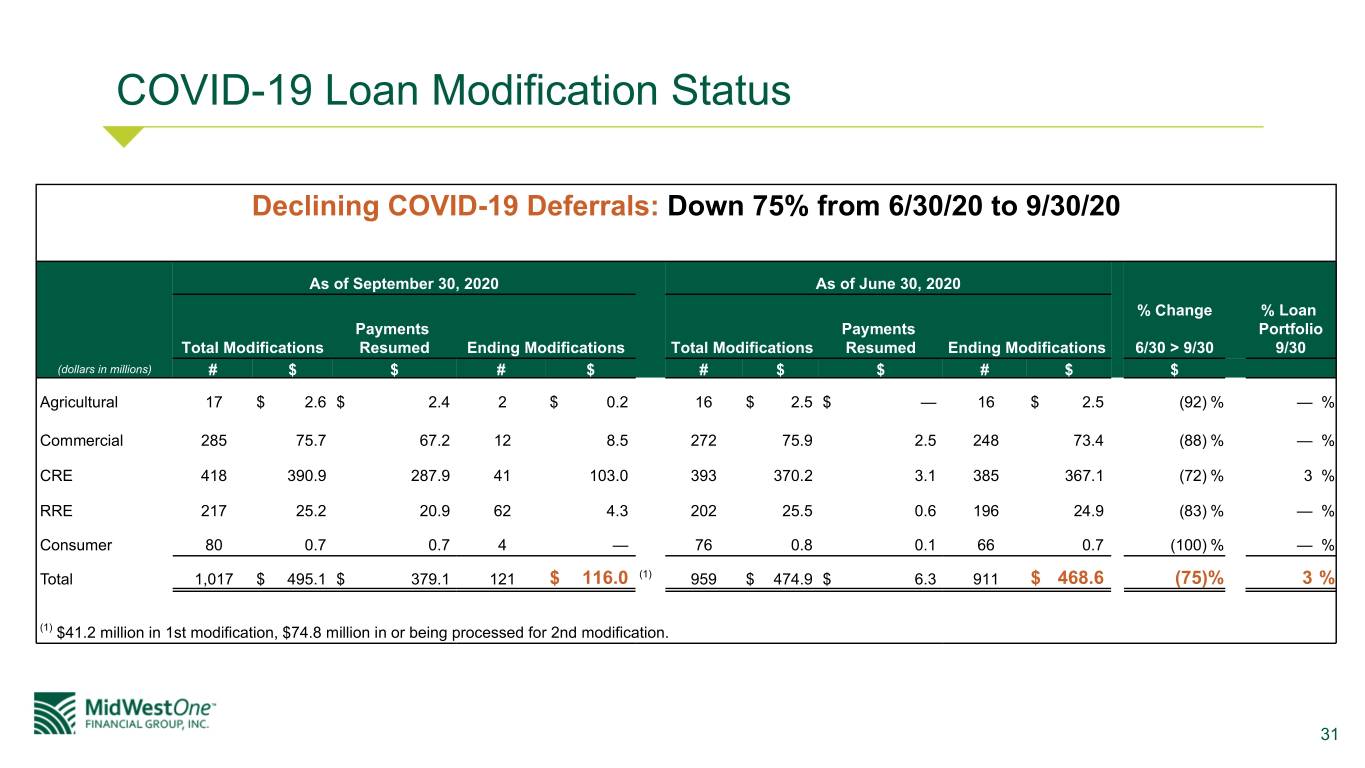
COVID-19 Loan Modification Status Declining COVID-19 Deferrals: Down 75% from 6/30/20 to 9/30/20 As of September 30, 2020 As of June 30, 2020 % Change % Loan Payments Payments Portfolio Total Modifications Resumed Ending Modifications Total Modifications Resumed Ending Modifications 6/30 > 9/30 9/30 (dollars in millions) # $ $ # $ # $ $ # $ $ Agricultural 17 $ 2.6 $ 2.4 2 $ 0.2 16 $ 2.5 $ — 16 $ 2.5 (92) % — % Commercial 285 75.7 67.2 12 8.5 272 75.9 2.5 248 73.4 (88) % — % CRE 418 390.9 287.9 41 103.0 393 370.2 3.1 385 367.1 (72) % 3 % RRE 217 25.2 20.9 62 4.3 202 25.5 0.6 196 24.9 (83) % — % Consumer 80 0.7 0.7 4 — 76 0.8 0.1 66 0.7 (100) % — % Total 1,017 $ 495.1 $ 379.1 121 $ 116.0 (1) 959 $ 474.9 $ 6.3 911 $ 468.6 (75) % 3 % (1) $41.2 million in 1st modification, $74.8 million in or being processed for 2nd modification. 31
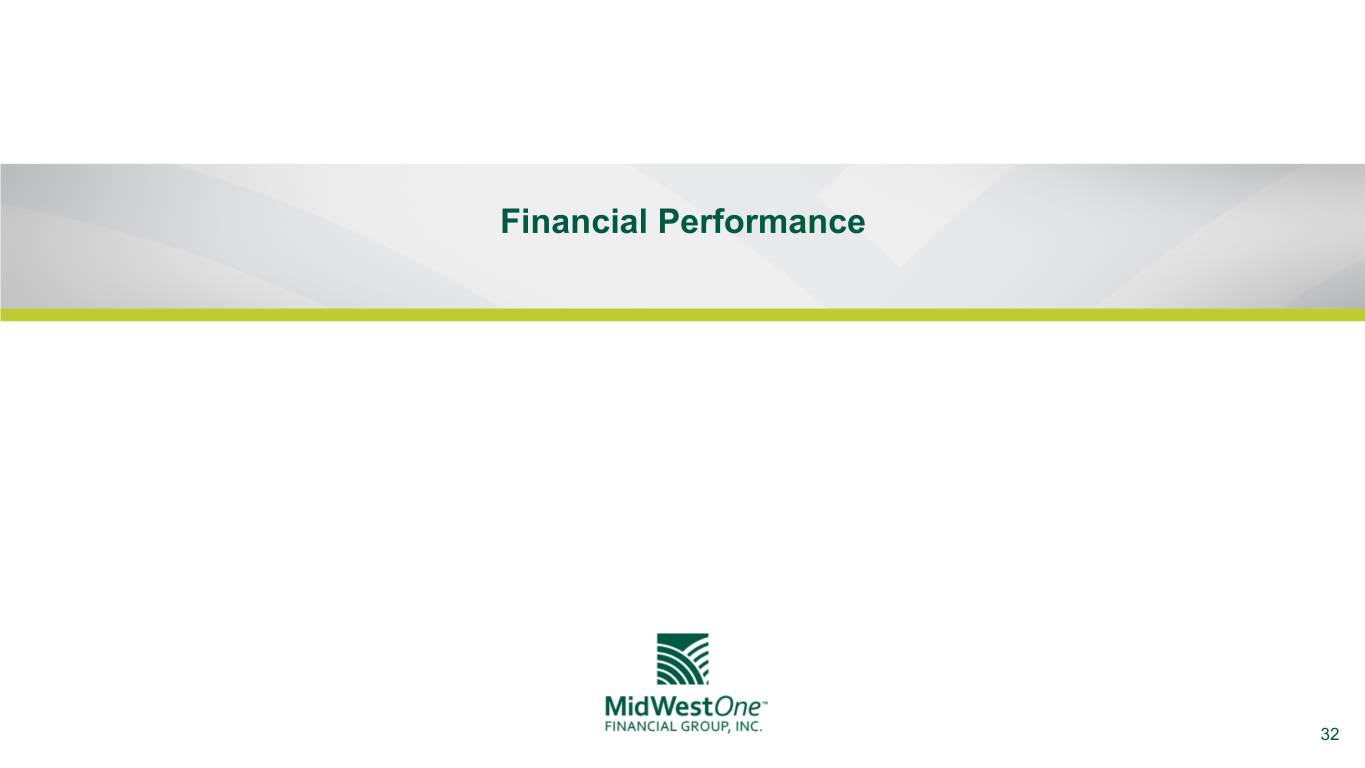
Financial Performance 32
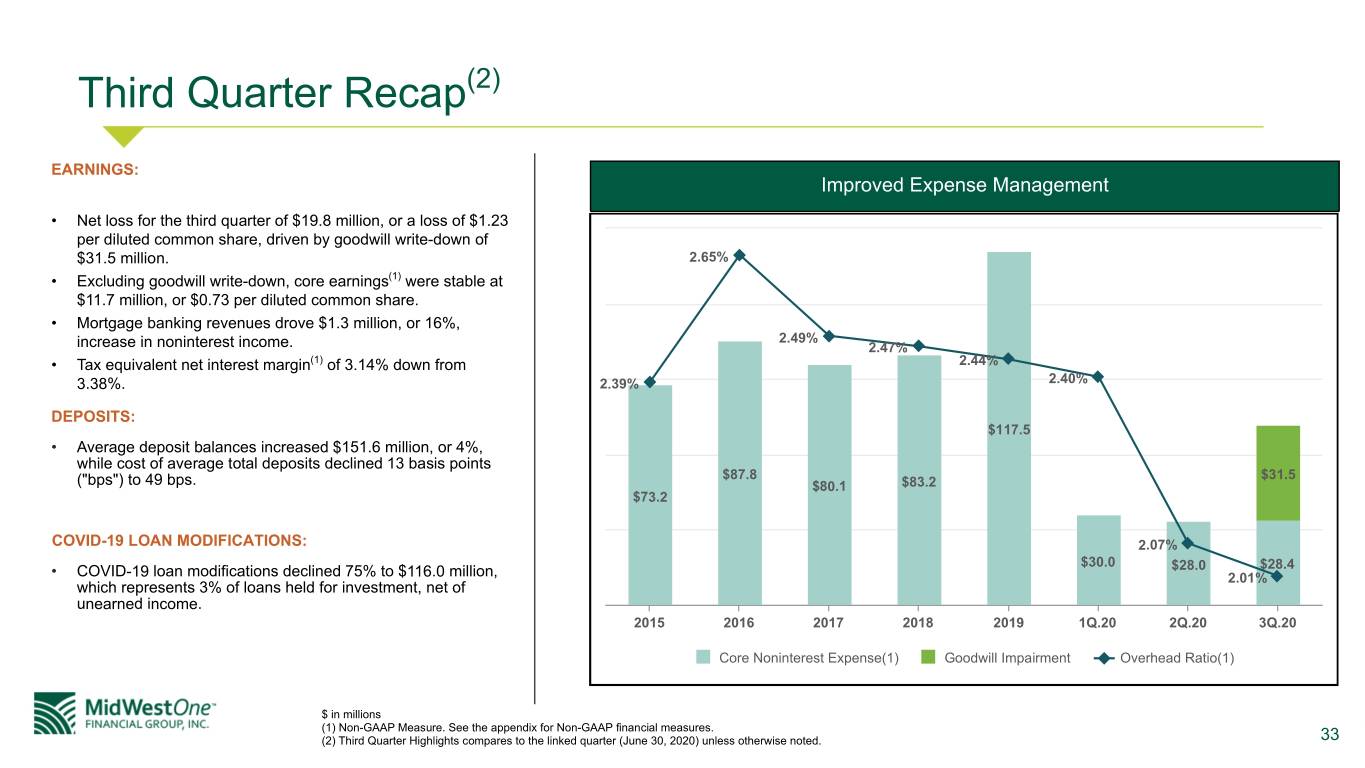
Third Quarter Recap(2) EARNINGS: Improved Expense Management • Net loss for the third quarter of $19.8 million, or a loss of $1.23 per diluted common share, driven by goodwill write-down of $31.5 million. 2.65% • Excluding goodwill write-down, core earnings(1) were stable at $11.7 million, or $0.73 per diluted common share. • Mortgage banking revenues drove $1.3 million, or 16%, 2.49% increase in noninterest income. 2.47% • Tax equivalent net interest margin(1) of 3.14% down from 2.44% 3.38%. 2.39% 2.40% DEPOSITS: $117.5 • Average deposit balances increased $151.6 million, or 4%, while cost of average total deposits declined 13 basis points $87.8 $31.5 ("bps") to 49 bps. $80.1 $83.2 $73.2 COVID-19 LOAN MODIFICATIONS: 2.07% $30.0 $28.0 $28.4 • COVID-19 loan modifications declined 75% to $116.0 million, 2.01% which represents 3% of loans held for investment, net of unearned income. 2015 2016 2017 2018 2019 1Q.20 2Q.20 3Q.20 Core Noninterest Expense(1) Goodwill Impairment Overhead Ratio(1) $ in millions (1) Non-GAAP Measure. See the appendix for Non-GAAP financial measures. (2) Third Quarter Highlights compares to the linked quarter (June 30, 2020) unless otherwise noted. 33
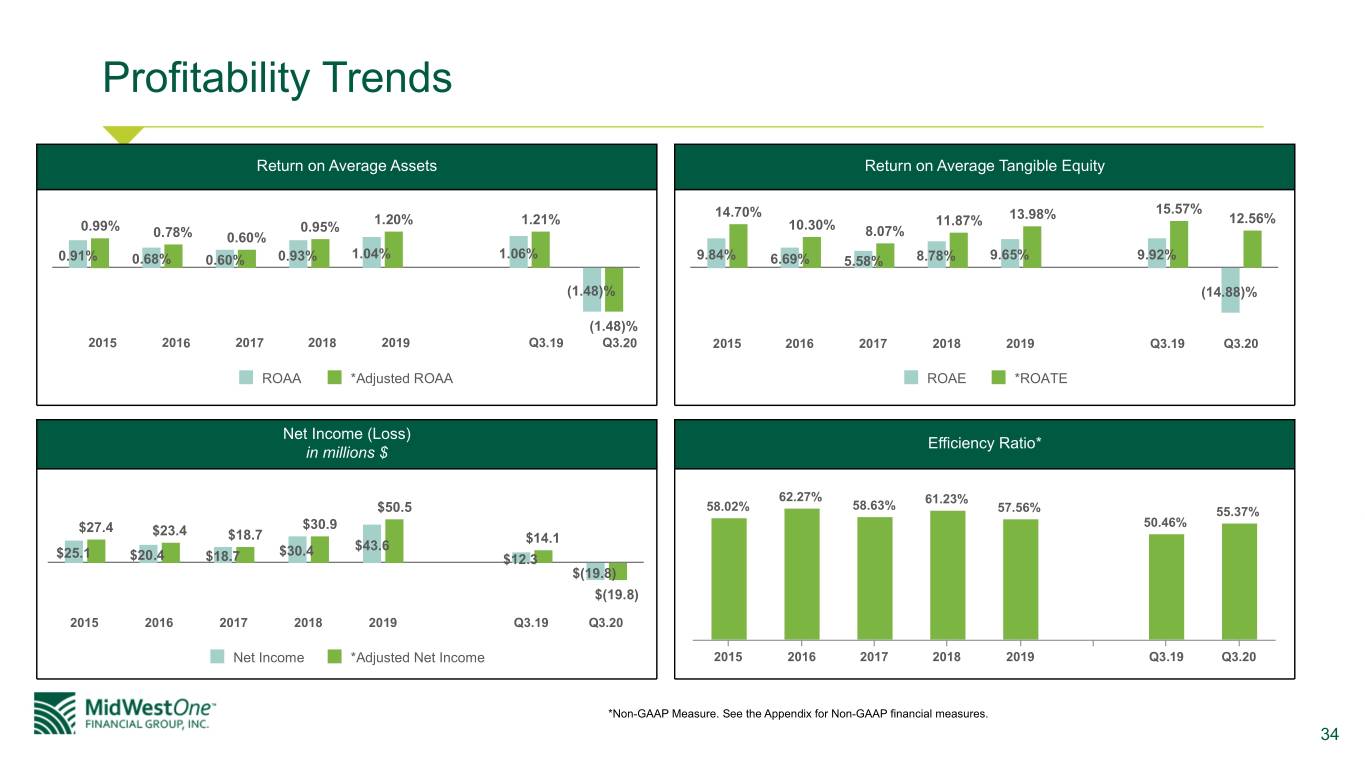
Profitability Trends Return on Average Assets Return on Average Tangible Equity 14.70% 15.57% 1.20% 1.21% 13.98% 12.56% 0.99% 0.95% 10.30% 11.87% 0.78% 0.60% 8.07% 1.04% 1.06% 0.91% 0.68% 0.60% 0.93% 9.84% 6.69% 5.58% 8.78% 9.65% 9.92% (1.48)% (14.88)% (1.48)% 2015 2016 2017 2018 2019 Q3.19 Q3.20 2015 2016 2017 2018 2019 Q3.19 Q3.20 ROAA *Adjusted ROAA ROAE *ROATE Net Income (Loss) Efficiency Ratio* in millions $ 62.27% 61.23% $50.5 58.02% 58.63% 57.56% 55.37% 50.46% $27.4 $23.4 $30.9 $18.7 $14.1 $30.4 $43.6 $25.1 $20.4 $18.7 $12.3 $(19.8) $(19.8) 2015 2016 2017 2018 2019 Q3.19 Q3.20 Net Income *Adjusted Net Income 2015 2016 2017 2018 2019 Q3.19 Q3.20 *Non-GAAP Measure. See the Appendix for Non-GAAP financial measures. 34
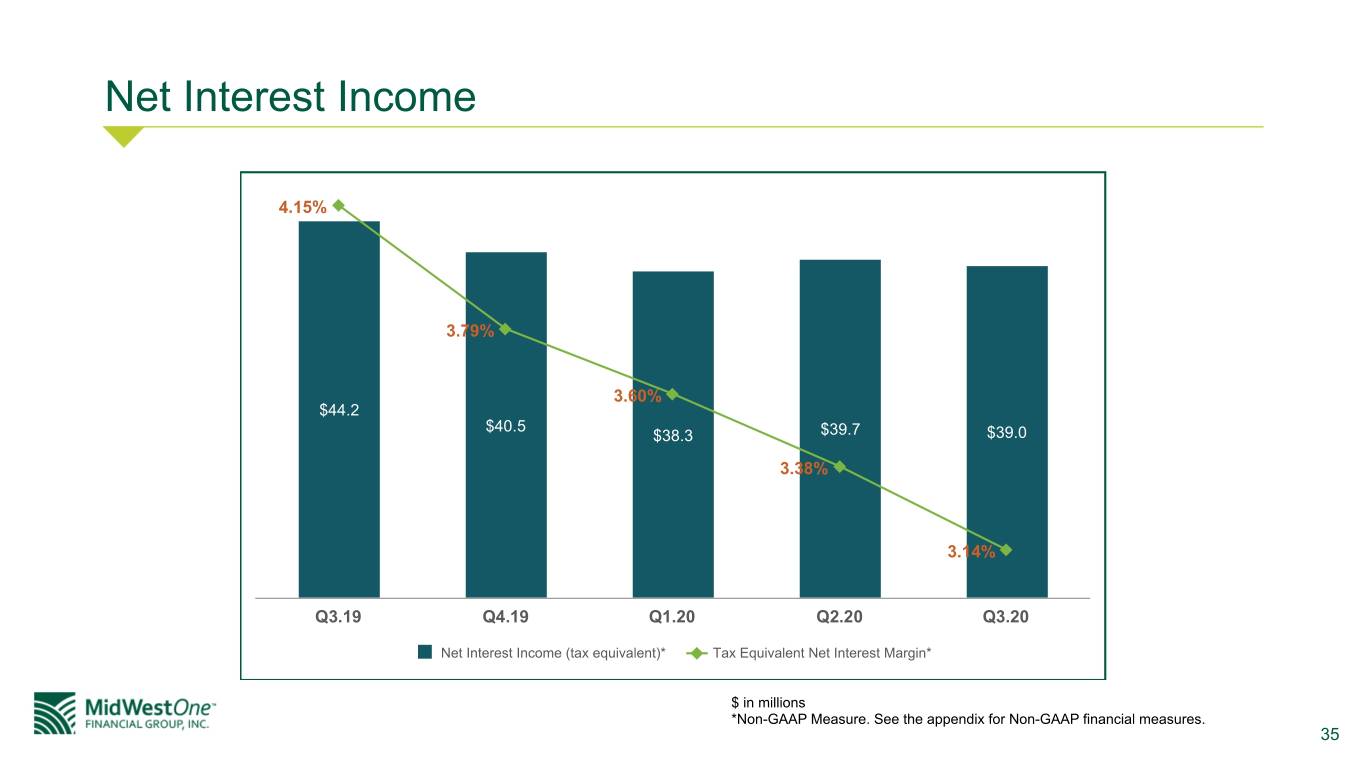
Net Interest Income 4.15% 3.79% 3.60% $44.2 $40.5 $38.3 $39.7 $39.0 3.38% 3.14% Q3.19 Q4.19 Q1.20 Q2.20 Q3.20 Net Interest Income (tax equivalent)* Tax Equivalent Net Interest Margin* $ in millions *Non-GAAP Measure. See the appendix for Non-GAAP financial measures. 35
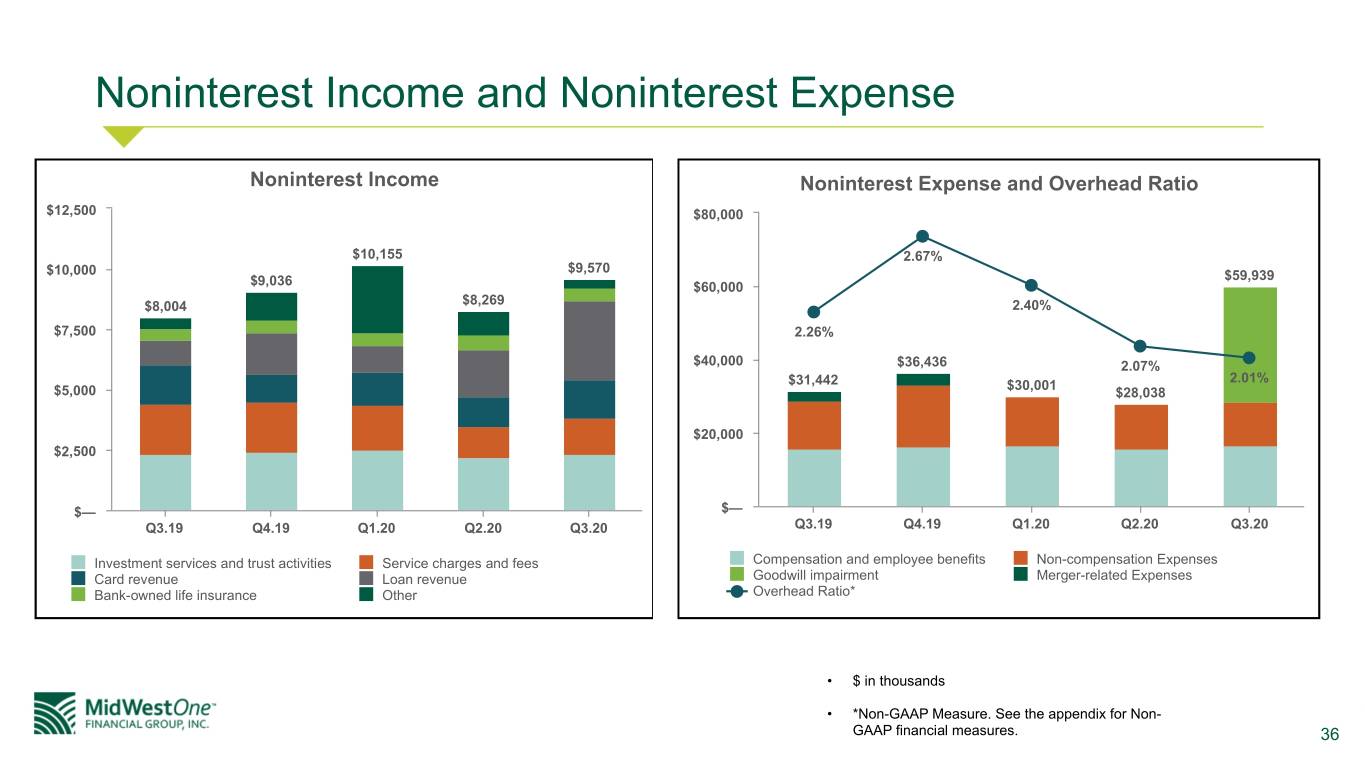
Noninterest Income and Noninterest Expense Noninterest Income Noninterest Expense and Overhead Ratio $12,500 $80,000 $10,155 2.67% $9,570 $10,000 $59,939 $9,036 $60,000 $8,004 $8,269 2.40% $7,500 2.26% $40,000 $36,436 2.07% 2.01% $31,442 $30,001 $5,000 $28,038 $20,000 $2,500 $— $— Q3.19 Q4.19 Q1.20 Q2.20 Q3.20 Q3.19 Q4.19 Q1.20 Q2.20 Q3.20 Investment services and trust activities Service charges and fees Compensation and employee benefits Non-compensation Expenses Card revenue Loan revenue Goodwill impairment Merger-related Expenses Bank-owned life insurance Other Overhead Ratio* • $ in thousands • *Non-GAAP Measure. See the appendix for Non- GAAP financial measures. 36
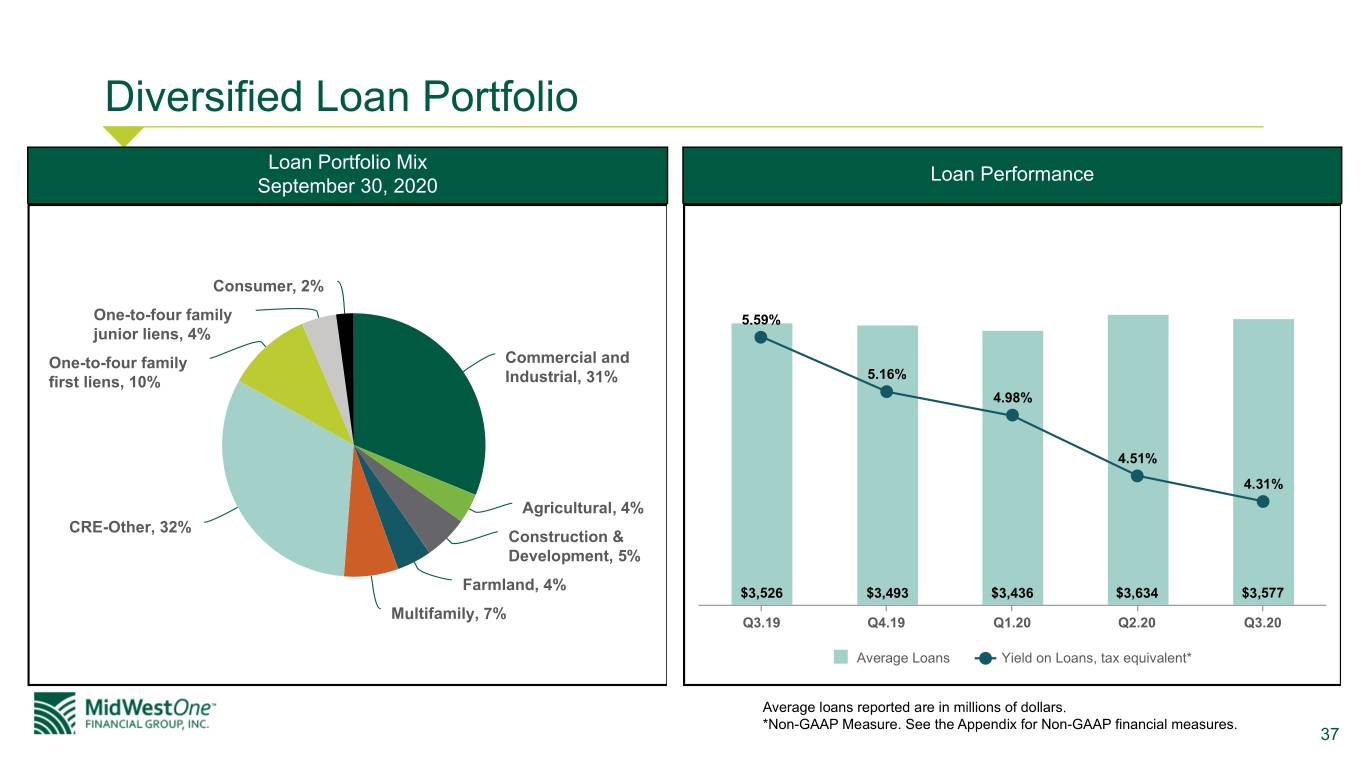
Diversified Loan Portfolio Loan Portfolio Mix Loan Performance September 30, 2020 Consumer, 2% One-to-four family 5.59% junior liens, 4% One-to-four family Commercial and first liens, 10% Industrial, 31% 5.16% 4.98% 4.51% 4.31% Agricultural, 4% CRE-Other, 32% Construction & Development, 5% Farmland, 4% $3,526 $3,493 $3,436 $3,634 $3,577 Multifamily, 7% Q3.19 Q4.19 Q1.20 Q2.20 Q3.20 Average Loans Yield on Loans, tax equivalent* Average loans reported are in millions of dollars. *Non-GAAP Measure. See the Appendix for Non-GAAP financial measures. 37
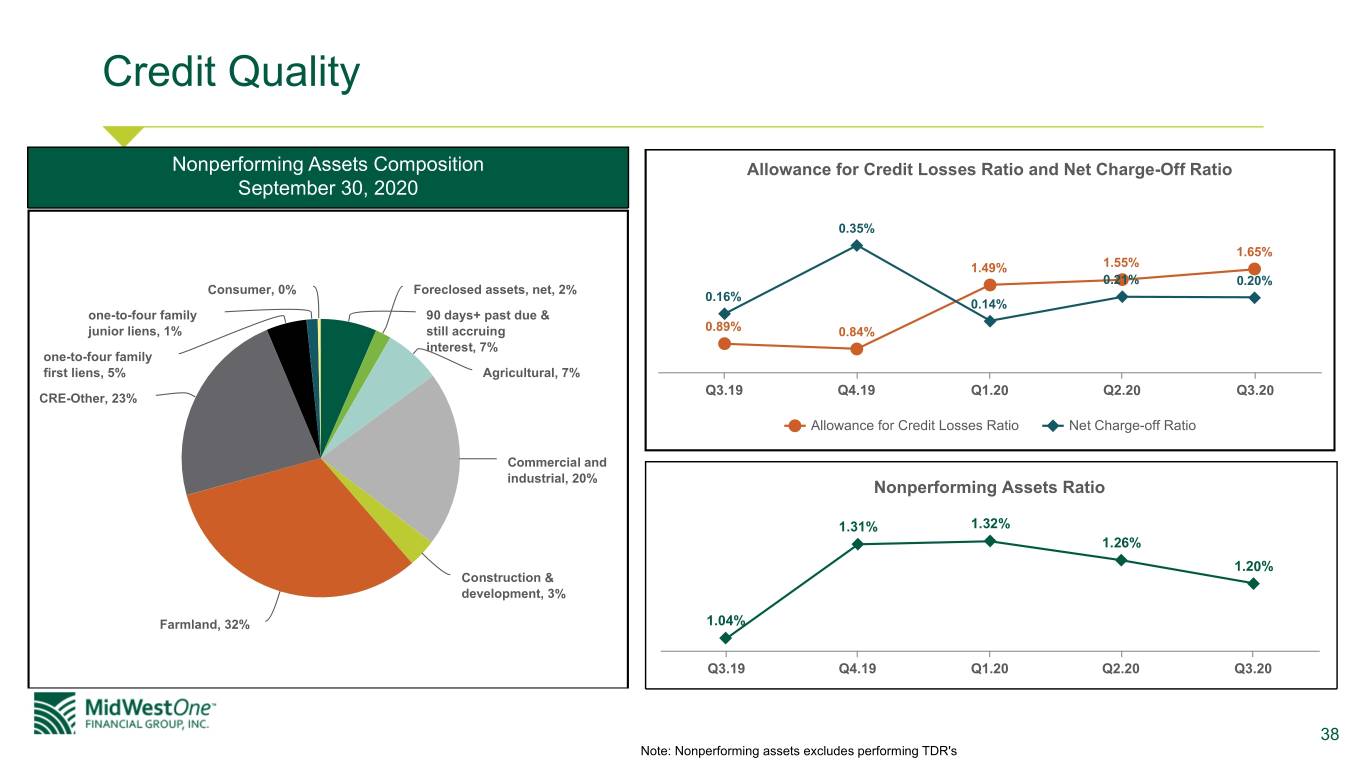
Credit Quality Nonperforming Assets Composition Allowance for Credit Losses Ratio and Net Charge-Off Ratio September 30, 2020 0.35% 1.65% 1.49% 1.55% 0.21% 0.20% Consumer, 0% Foreclosed assets, net, 2% 0.16% 0.14% one-to-four family 90 days+ past due & junior liens, 1% still accruing 0.89% 0.84% interest, 7% one-to-four family first liens, 5% Agricultural, 7% Q3.19 Q4.19 Q1.20 Q2.20 Q3.20 CRE-Other, 23% Allowance for Credit Losses Ratio Net Charge-off Ratio Commercial and industrial, 20% Nonperforming Assets Ratio 1.31% 1.32% 1.26% 1.20% Construction & development, 3% Farmland, 32% 1.04% Q3.19 Q4.19 Q1.20 Q2.20 Q3.20 38 Note: Nonperforming assets excludes performing TDR's
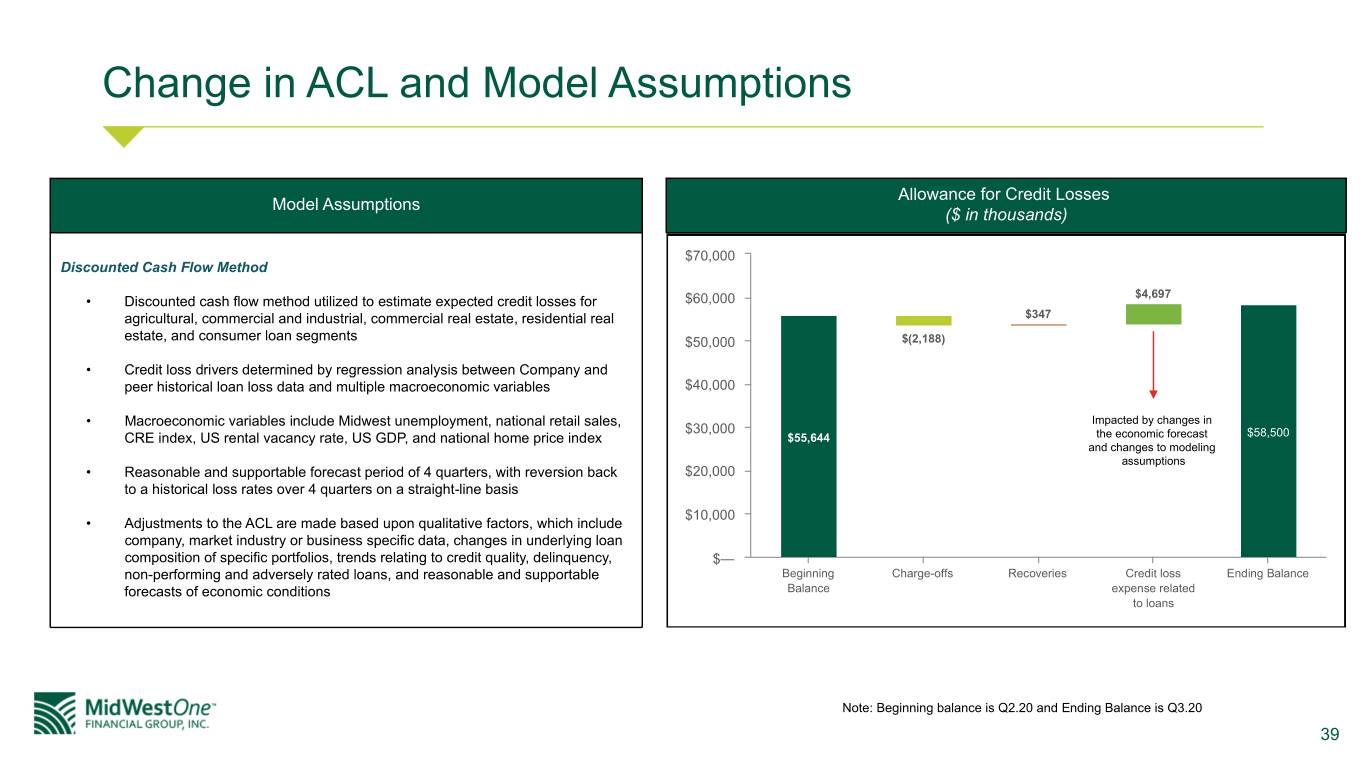
Change in ACL and Model Assumptions Allowance for Credit Losses Model Assumptions ($ in thousands) $70,000 Discounted Cash Flow Method $4,697 • Discounted cash flow method utilized to estimate expected credit losses for $60,000 agricultural, commercial and industrial, commercial real estate, residential real $347 estate, and consumer loan segments $50,000 $(2,188) • Credit loss drivers determined by regression analysis between Company and peer historical loan loss data and multiple macroeconomic variables $40,000 • Macroeconomic variables include Midwest unemployment, national retail sales, Impacted by changes in $30,000 CRE index, US rental vacancy rate, US GDP, and national home price index $55,644 the economic forecast $58,500 and changes to modeling assumptions • Reasonable and supportable forecast period of 4 quarters, with reversion back $20,000 to a historical loss rates over 4 quarters on a straight-line basis $10,000 • Adjustments to the ACL are made based upon qualitative factors, which include company, market industry or business specific data, changes in underlying loan composition of specific portfolios, trends relating to credit quality, delinquency, $— non-performing and adversely rated loans, and reasonable and supportable Beginning Charge-offs Recoveries Credit loss Ending Balance forecasts of economic conditions Balance expense related to loans Note: Beginning balance is Q2.20 and Ending Balance is Q3.20 39
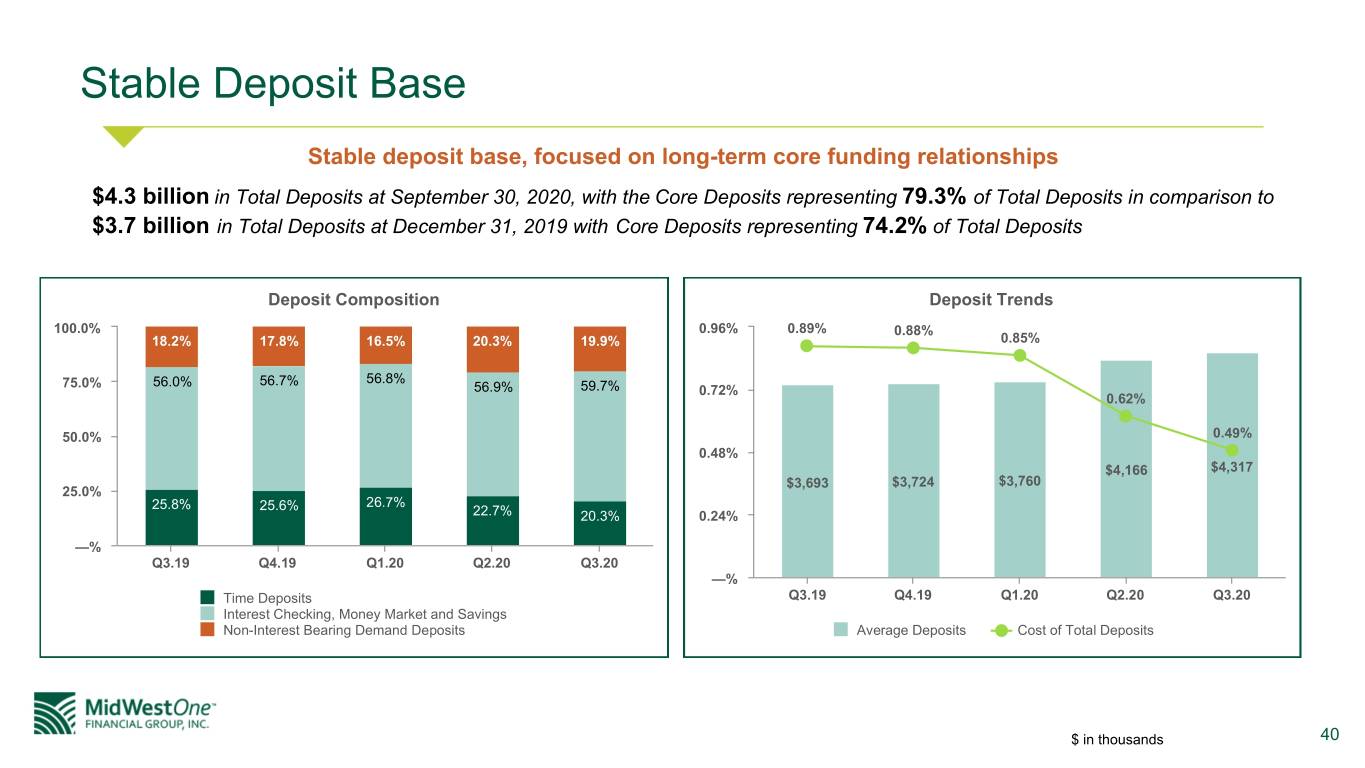
Stable Deposit Base Stable deposit base, focused on long-term core funding relationships $4.3 billion in Total Deposits at September 30, 2020, with the Core Deposits representing 79.3% of Total Deposits in comparison to $3.7 billion in Total Deposits at December 31, 2019 with Core Deposits representing 74.2% of Total Deposits Deposit Composition Deposit Trends 100.0% 0.96% 0.89% 0.88% 18.2% 17.8% 16.5% 20.3% 19.9% 0.85% 75.0% 56.0% 56.7% 56.8% 56.9% 59.7% 0.72% 0.62% 50.0% 0.49% 0.48% $4,166 $4,317 $3,693 $3,724 $3,760 25.0% 25.8% 25.6% 26.7% 22.7% 20.3% 0.24% —% Q3.19 Q4.19 Q1.20 Q2.20 Q3.20 —% Time Deposits Q3.19 Q4.19 Q1.20 Q2.20 Q3.20 Interest Checking, Money Market and Savings Non-Interest Bearing Demand Deposits Average Deposits Cost of Total Deposits $ in thousands 40
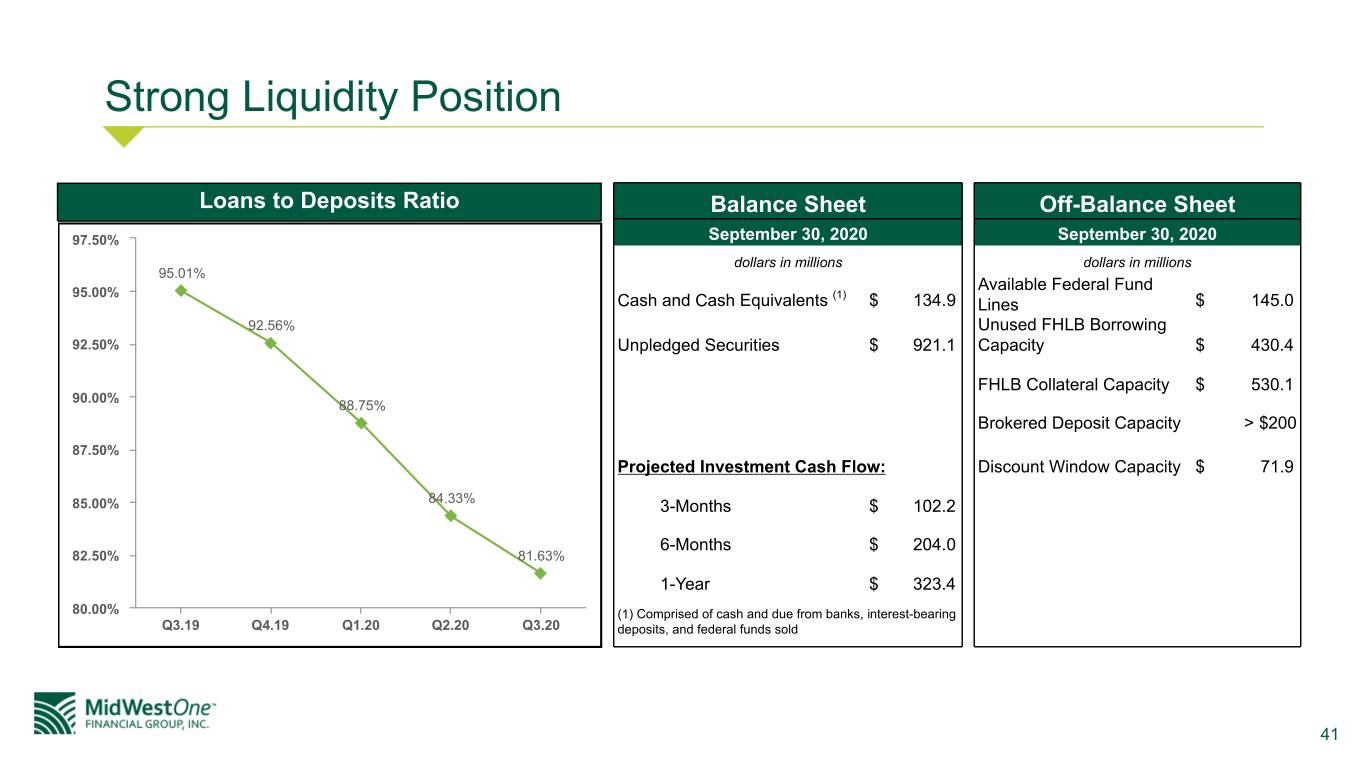
Strong Liquidity Position Loans to Deposits Ratio Balance Sheet Off-Balance Sheet 97.50% September 30, 2020 September 30, 2020 dollars in millions dollars in millions 95.01% Available Federal Fund 95.00% (1) Cash and Cash Equivalents $ 134.9 Lines $ 145.0 92.56% Unused FHLB Borrowing 92.50% Unpledged Securities $ 921.1 Capacity $ 430.4 FHLB Collateral Capacity $ 530.1 90.00% 88.75% Brokered Deposit Capacity > $200 87.50% Projected Investment Cash Flow: Discount Window Capacity $ 71.9 85.00% 84.33% 3-Months $ 102.2 6-Months $ 204.0 82.50% 81.63% 1-Year $ 323.4 80.00% (1) Comprised of cash and due from banks, interest-bearing Q3.19 Q4.19 Q1.20 Q2.20 Q3.20 deposits, and federal funds sold 41
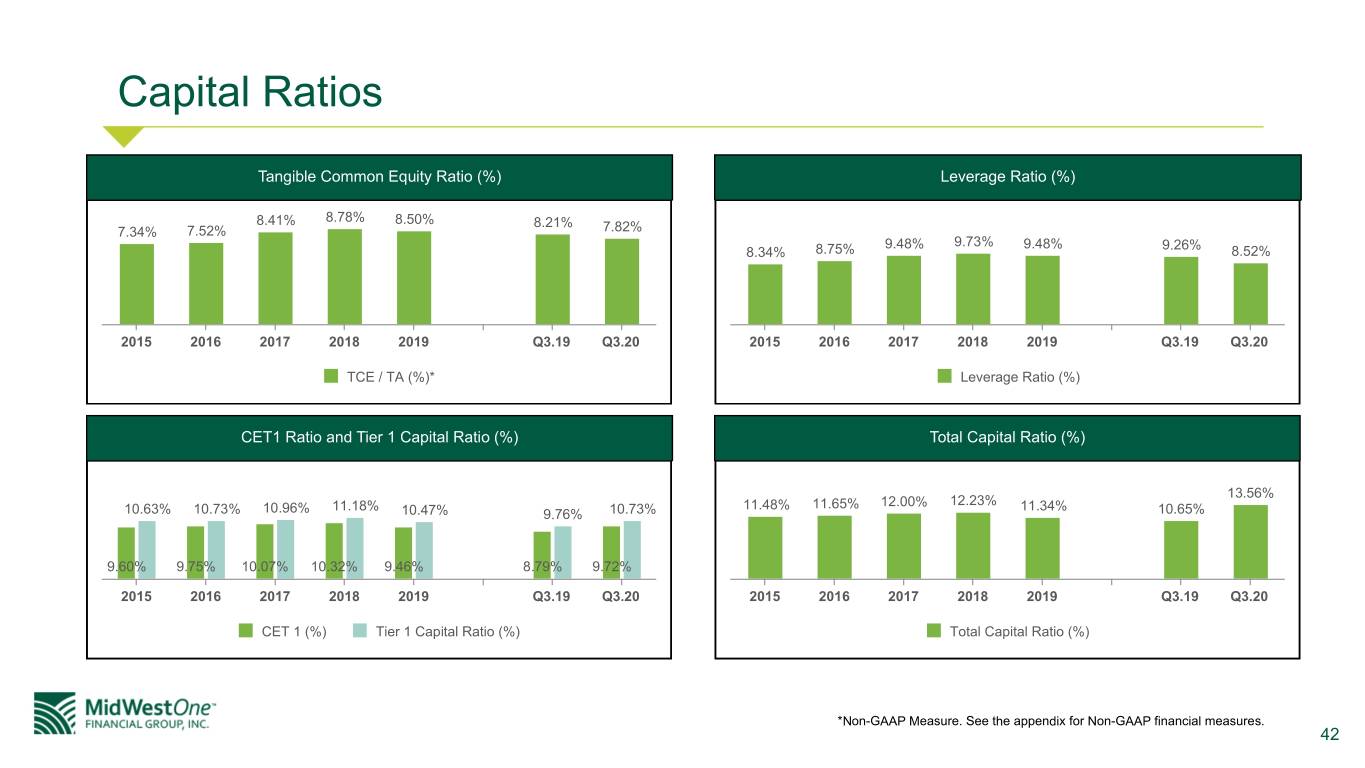
Capital Ratios Tangible Common Equity Ratio (%) Leverage Ratio (%) 8.41% 8.78% 8.50% 8.21% 7.34% 7.52% 7.82% 9.48% 9.73% 9.48% 9.26% 8.34% 8.75% 8.52% 2015 2016 2017 2018 2019 Q3.19 Q3.20 2015 2016 2017 2018 2019 Q3.19 Q3.20 TCE / TA (%)* Leverage Ratio (%) CET1 Ratio and Tier 1 Capital Ratio (%) Total Capital Ratio (%) 13.56% 11.18% 11.48% 11.65% 12.00% 12.23% 11.34% 10.63% 10.73% 10.96% 10.47% 9.76% 10.73% 10.65% 9.60% 9.75% 10.07% 10.32% 9.46% 8.79% 9.72% 2015 2016 2017 2018 2019 Q3.19 Q3.20 2015 2016 2017 2018 2019 Q3.19 Q3.20 CET 1 (%) Tier 1 Capital Ratio (%) Total Capital Ratio (%) *Non-GAAP Measure. See the appendix for Non-GAAP financial measures. 42
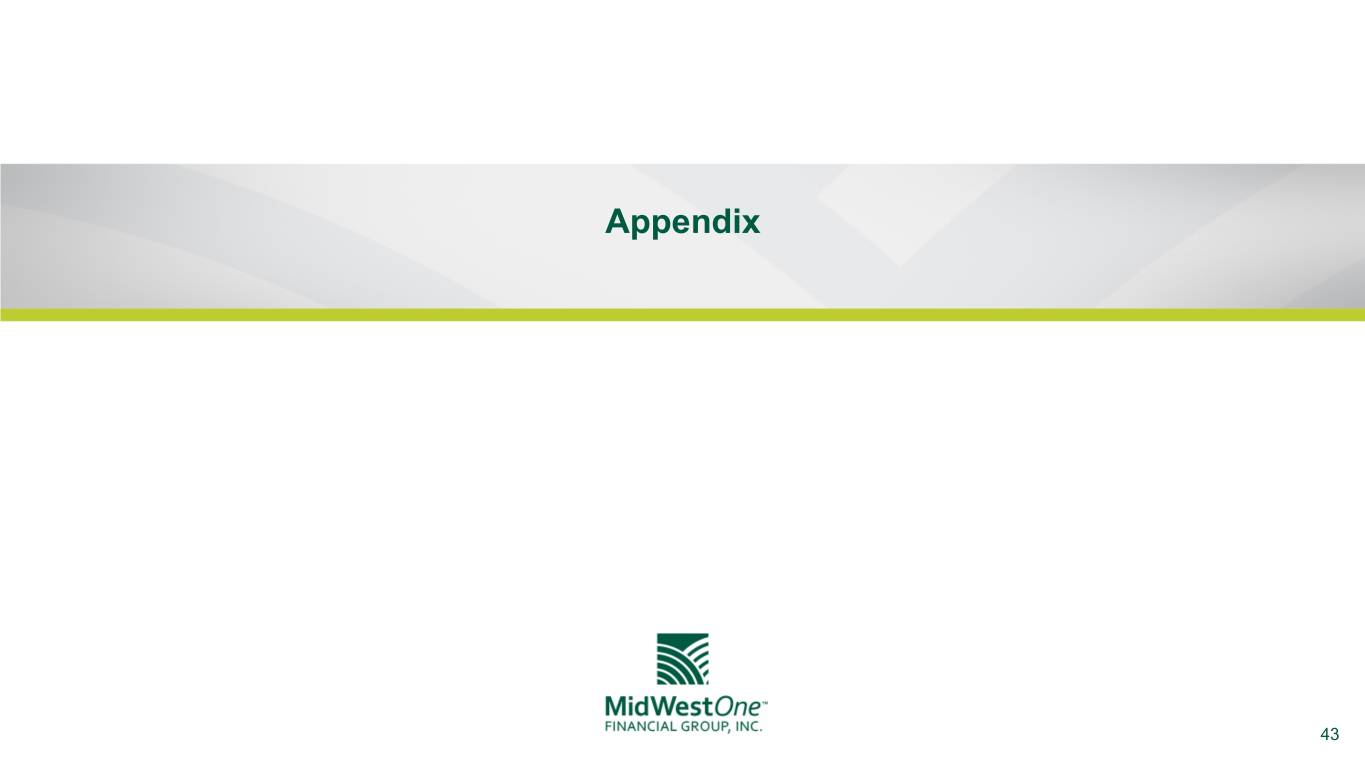
Appendix 43
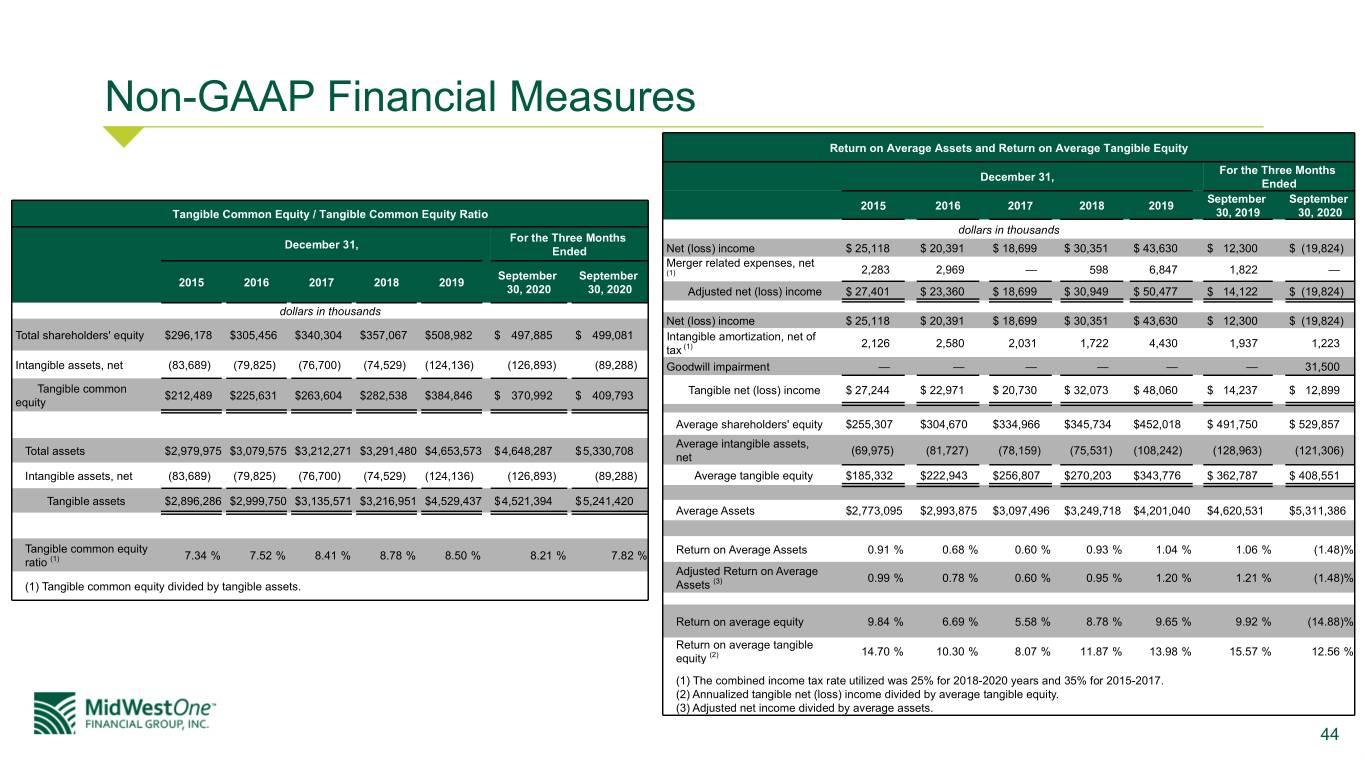
Non-GAAP Financial Measures Return on Average Assets and Return on Average Tangible Equity For the Three Months December 31, Ended September September 2015 2016 2017 2018 2019 Tangible Common Equity / Tangible Common Equity Ratio 30, 2019 30, 2020 dollars in thousands For the Three Months December 31, Ended Net (loss) income $ 25,118 $ 20,391 $ 18,699 $ 30,351 $ 43,630 $ 12,300 $ (19,824) Merger related expenses, net 2,283 2,969 — 598 6,847 1,822 — September September (1) 2015 2016 2017 2018 2019 30, 2020 30, 2020 Adjusted net (loss) income $ 27,401 $ 23,360 $ 18,699 $ 30,949 $ 50,477 $ 14,122 $ (19,824) dollars in thousands Net (loss) income $ 25,118 $ 20,391 $ 18,699 $ 30,351 $ 43,630 $ 12,300 $ (19,824) Total shareholders' equity $ 296,178 $ 305,456 $ 340,304 $ 357,067 $ 508,982 $ 497,885 $ 499,081 Intangible amortization, net of 2,126 2,580 2,031 1,722 4,430 1,937 1,223 tax (1) Intangible assets, net (83,689) (79,825) (76,700) (74,529) (124,136) (126,893) (89,288) Goodwill impairment — — — — — — 31,500 Tangible common $ 212,489 $ 225,631 $ 263,604 $ 282,538 $ 384,846 $ 370,992 $ 409,793 Tangible net (loss) income $ 27,244 $ 22,971 $ 20,730 $ 32,073 $ 48,060 $ 14,237 $ 12,899 equity Average shareholders' equity $ 255,307 $ 304,670 $ 334,966 $ 345,734 $ 452,018 $ 491,750 $ 529,857 Average intangible assets, Total assets $ 2,979,975 $ 3,079,575 $ 3,212,271 $ 3,291,480 $ 4,653,573 $ 4,648,287 $ 5,330,708 (69,975) (81,727) (78,159) (75,531) (108,242) (128,963) (121,306) net Intangible assets, net (83,689) (79,825) (76,700) (74,529) (124,136) (126,893) (89,288) Average tangible equity $ 185,332 $ 222,943 $ 256,807 $ 270,203 $ 343,776 $ 362,787 $ 408,551 Tangible assets $ 2,896,286 $ 2,999,750 $ 3,135,571 $ 3,216,951 $ 4,529,437 $ 4,521,394 $ 5,241,420 Average Assets $ 2,773,095 $ 2,993,875 $ 3,097,496 $ 3,249,718 $ 4,201,040 $ 4,620,531 $ 5,311,386 Tangible common equity Return on Average Assets 0.91 % 0.68 % 0.60 % 0.93 % 1.04 % 1.06 % (1.48) % 7.34 % 7.52 % 8.41 % 8.78 % 8.50 % 8.21 % 7.82 % ratio (1) Adjusted Return on Average (3) 0.99 % 0.78 % 0.60 % 0.95 % 1.20 % 1.21 % (1.48) % (1) Tangible common equity divided by tangible assets. Assets Return on average equity 9.84 % 6.69 % 5.58 % 8.78 % 9.65 % 9.92 % (14.88) % Return on average tangible 14.70 % 10.30 % 8.07 % 11.87 % 13.98 % 15.57 % 12.56 % equity (2) (1) The combined income tax rate utilized was 25% for 2018-2020 years and 35% for 2015-2017. (2) Annualized tangible net (loss) income divided by average tangible equity. (3) Adjusted net income divided by average assets. 44
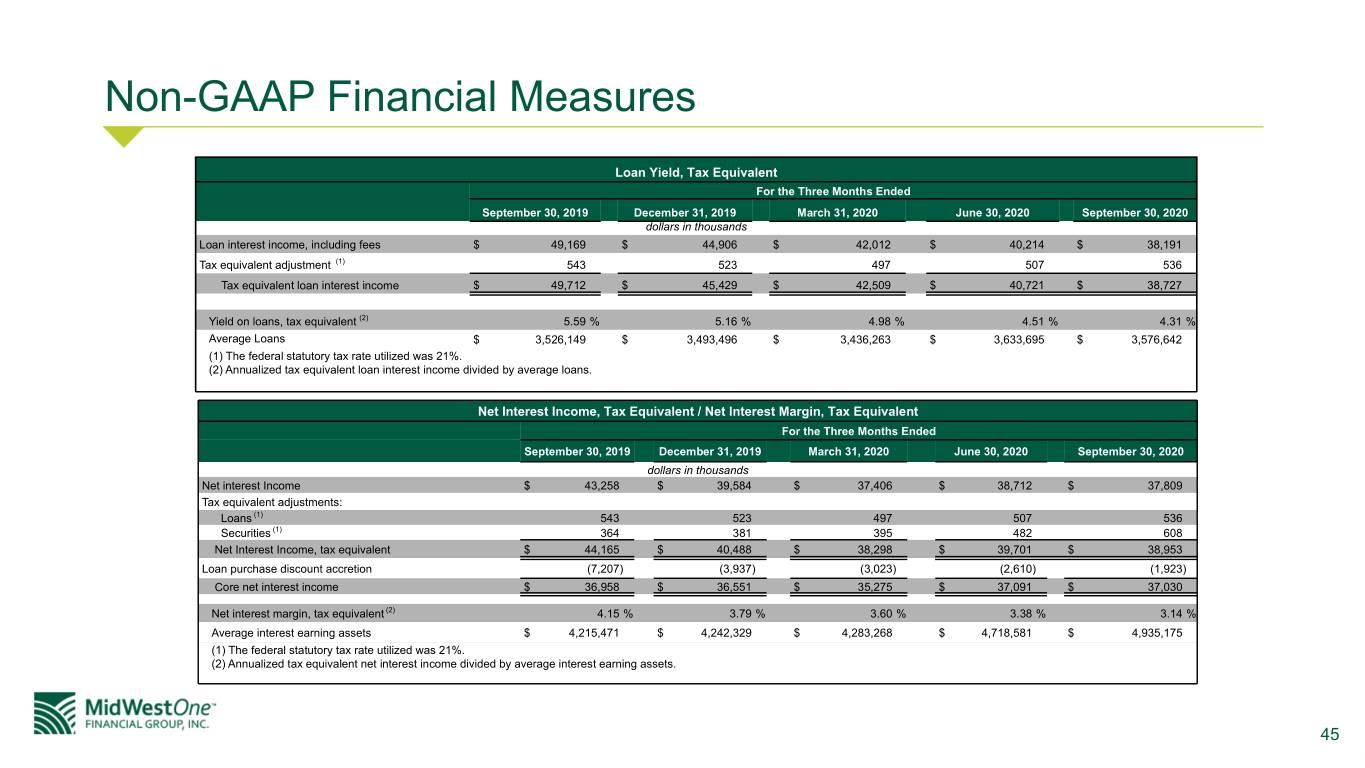
Non-GAAP Financial Measures Loan Yield, Tax Equivalent For the Three Months Ended September 30, 2019 December 31, 2019 March 31, 2020 June 30, 2020 September 30, 2020 dollars in thousands Loan interest income, including fees $ 49,169 $ 44,906 $ 42,012 $ 40,214 $ 38,191 Tax equivalent adjustment (1) 543 523 497 507 536 Tax equivalent loan interest income $ 49,712 $ 45,429 $ 42,509 $ 40,721 $ 38,727 Yield on loans, tax equivalent (2) 5.59 % 5.16 % 4.98 % 4.51 % 4.31 % Average Loans $ 3,526,149 $ 3,493,496 $ 3,436,263 $ 3,633,695 $ 3,576,642 (1) The federal statutory tax rate utilized was 21%. (2) Annualized tax equivalent loan interest income divided by average loans. Net Interest Income, Tax Equivalent / Net Interest Margin, Tax Equivalent For the Three Months Ended September 30, 2019 December 31, 2019 March 31, 2020 June 30, 2020 September 30, 2020 dollars in thousands Net interest Income $ 43,258 $ 39,584 $ 37,406 $ 38,712 $ 37,809 Tax equivalent adjustments: Loans (1) 543 523 497 507 536 Securities (1) 364 381 395 482 608 Net Interest Income, tax equivalent $ 44,165 $ 40,488 $ 38,298 $ 39,701 $ 38,953 Loan purchase discount accretion (7,207) (3,937) (3,023) (2,610) (1,923) Core net interest income $ 36,958 $ 36,551 $ 35,275 $ 37,091 $ 37,030 Net interest margin, tax equivalent (2) 4.15 % 3.79 % 3.60 % 3.38 % 3.14 % Average interest earning assets $ 4,215,471 $ 4,242,329 $ 4,283,268 $ 4,718,581 $ 4,935,175 (1) The federal statutory tax rate utilized was 21%. (2) Annualized tax equivalent net interest income divided by average interest earning assets. 45
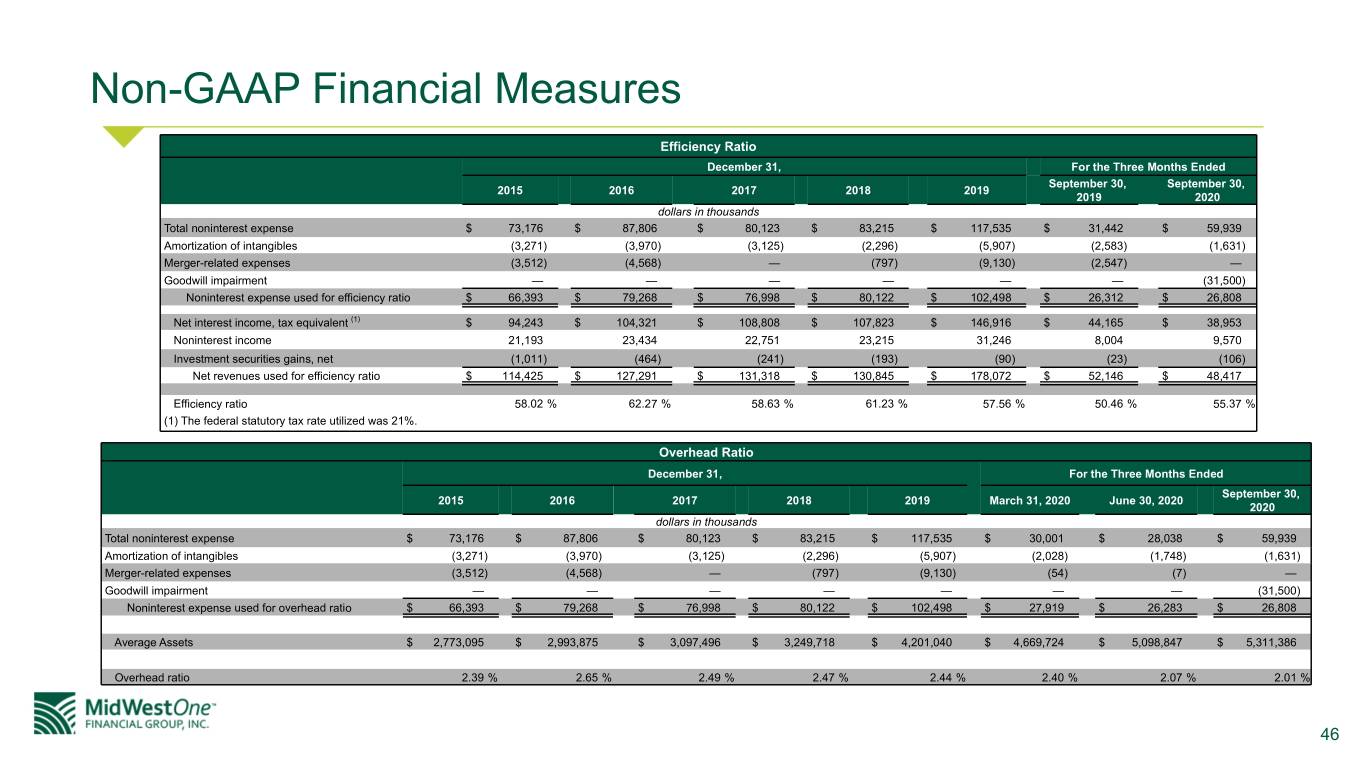
Non-GAAP Financial Measures Efficiency Ratio December 31, For the Three Months Ended September 30, September 30, 2015 2016 2017 2018 2019 2019 2020 dollars in thousands Total noninterest expense $ 73,176 $ 87,806 $ 80,123 $ 83,215 $ 117,535 $ 31,442 $ 59,939 Amortization of intangibles (3,271) (3,970) (3,125) (2,296) (5,907) (2,583) (1,631) Merger-related expenses (3,512) (4,568) — (797) (9,130) (2,547) — Goodwill impairment — — — — — — (31,500) Noninterest expense used for efficiency ratio $ 66,393 $ 79,268 $ 76,998 $ 80,122 $ 102,498 $ 26,312 $ 26,808 Net interest income, tax equivalent (1) $ 94,243 $ 104,321 $ 108,808 $ 107,823 $ 146,916 $ 44,165 $ 38,953 Noninterest income 21,193 23,434 22,751 23,215 31,246 8,004 9,570 Investment securities gains, net (1,011) (464) (241) (193) (90) (23) (106) Net revenues used for efficiency ratio $ 114,425 $ 127,291 $ 131,318 $ 130,845 $ 178,072 $ 52,146 $ 48,417 Efficiency ratio 58.02 % 62.27 % 58.63 % 61.23 % 57.56 % 50.46 % 55.37 % (1) The federal statutory tax rate utilized was 21%. Overhead Ratio December 31, For the Three Months Ended September 30, 2015 2016 2017 2018 2019 March 31, 2020 June 30, 2020 2020 dollars in thousands Total noninterest expense $ 73,176 $ 87,806 $ 80,123 $ 83,215 $ 117,535 $ 30,001 $ 28,038 $ 59,939 Amortization of intangibles (3,271) (3,970) (3,125) (2,296) (5,907) (2,028) (1,748) (1,631) Merger-related expenses (3,512) (4,568) — (797) (9,130) (54) (7) — Goodwill impairment — — — — — — — (31,500) Noninterest expense used for overhead ratio $ 66,393 $ 79,268 $ 76,998 $ 80,122 $ 102,498 $ 27,919 $ 26,283 $ 26,808 Average Assets $ 2,773,095 $ 2,993,875 $ 3,097,496 $ 3,249,718 $ 4,201,040 $ 4,669,724 $ 5,098,847 $ 5,311,386 Overhead ratio 2.39 % 2.65 % 2.49 % 2.47 % 2.44 % 2.40 % 2.07 % 2.01 % 46
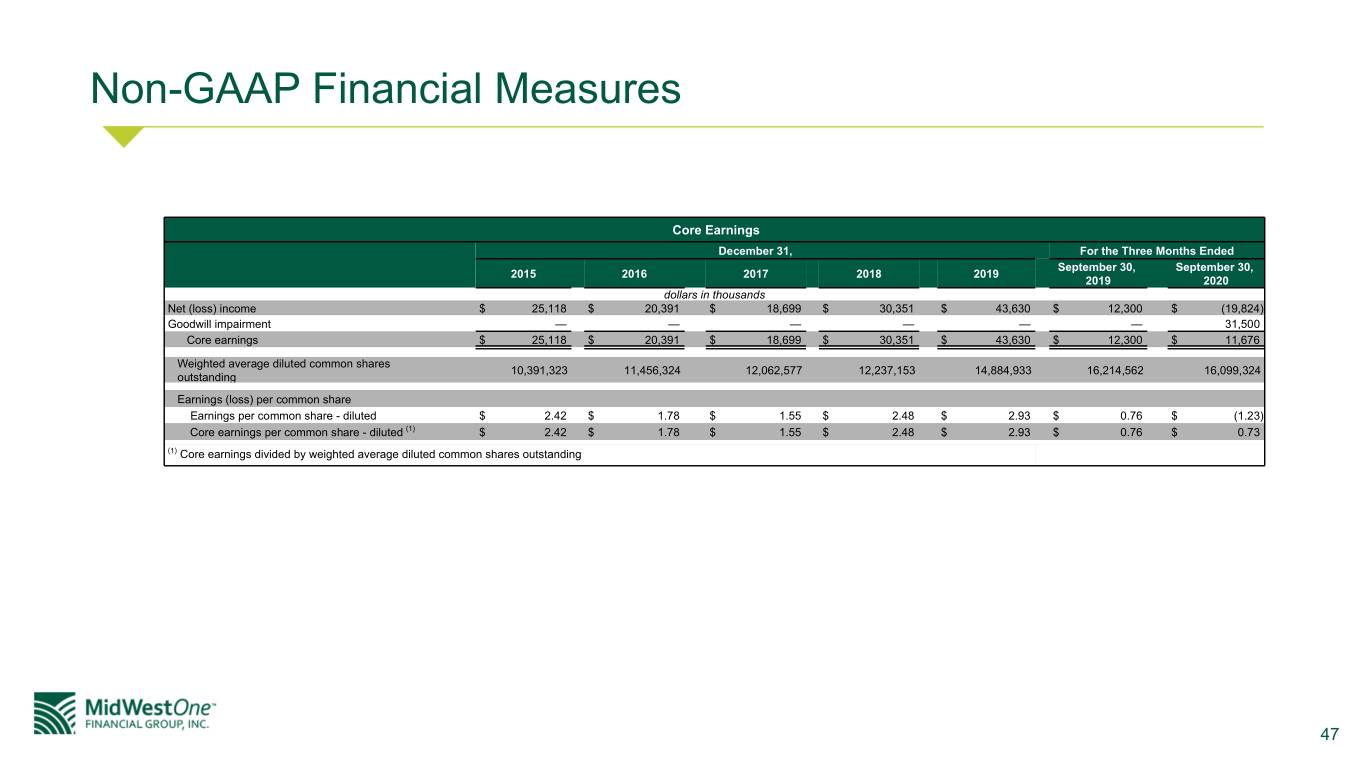
Non-GAAP Financial Measures Core Earnings December 31, For the Three Months Ended September 30, September 30, 2015 2016 2017 2018 2019 2019 2020 dollars in thousands Net (loss) income $ 25,118 $ 20,391 $ 18,699 $ 30,351 $ 43,630 $ 12,300 $ (19,824) Goodwill impairment — — — — — — 31,500 Core earnings $ 25,118 $ 20,391 $ 18,699 $ 30,351 $ 43,630 $ 12,300 $ 11,676 Weighted average diluted common shares 10,391,323 11,456,324 12,062,577 12,237,153 14,884,933 16,214,562 16,099,324 outstanding Earnings (loss) per common share Earnings per common share - diluted $ 2.42 $ 1.78 $ 1.55 $ 2.48 $ 2.93 $ 0.76 $ (1.23) Core earnings per common share - diluted (1) $ 2.42 $ 1.78 $ 1.55 $ 2.48 $ 2.93 $ 0.76 $ 0.73 (1) Core earnings divided by weighted average diluted common shares outstanding 47
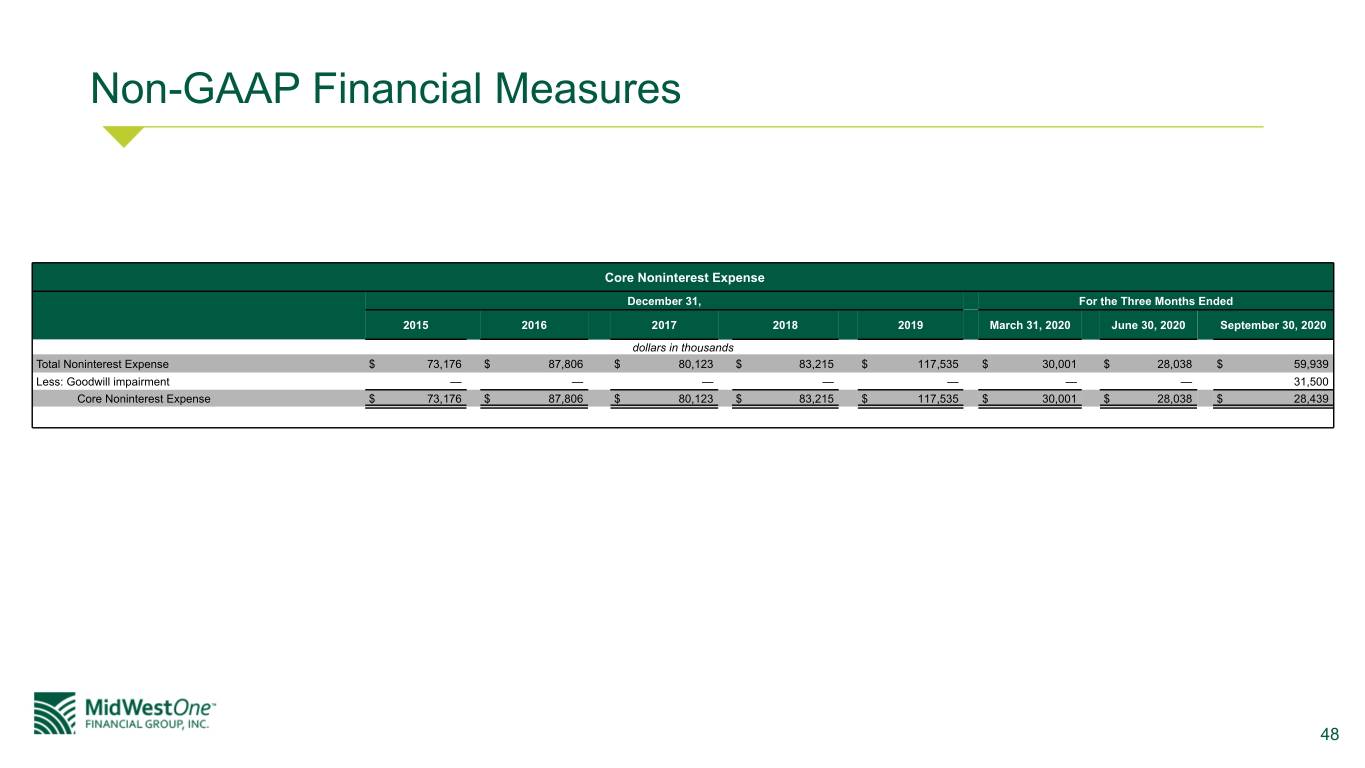
Non-GAAP Financial Measures Core Noninterest Expense December 31, For the Three Months Ended 2015 2016 2017 2018 2019 March 31, 2020 June 30, 2020 September 30, 2020 dollars in thousands Total Noninterest Expense $ 73,176 $ 87,806 $ 80,123 $ 83,215 $ 117,535 $ 30,001 $ 28,038 $ 59,939 Less: Goodwill impairment — — — — — — — 31,500 Core Noninterest Expense $ 73,176 $ 87,806 $ 80,123 $ 83,215 $ 117,535 $ 30,001 $ 28,038 $ 28,439 48
